 Walks and other things
Walks and other things
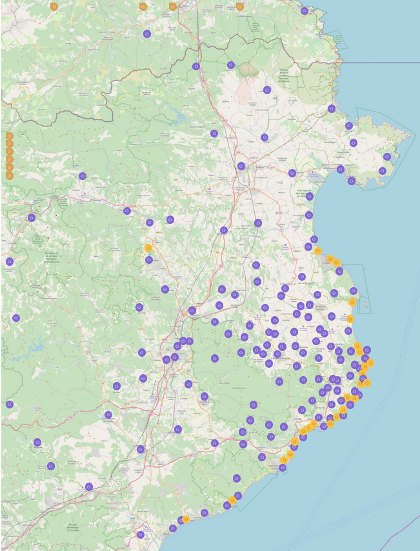 One of the joys of the Costa Brava is the variety of landscapes and we like to visit places and walk (a lot), particularly into and around the Gavarres. Sometimes we travel around on bike. In the summer, we swim and canoe.
One of the joys of the Costa Brava is the variety of landscapes and we like to visit places and walk (a lot), particularly into and around the Gavarres. Sometimes we travel around on bike. In the summer, we swim and canoe.
These then are write ups of walks, hikes and activities that we've done since November 2012, with photos straight from the original walk or activity.
We like to make circular walks and our walks range in length from about 4km (an hour) to around 16km (four hours) - but probably about 2 1/2 hours on average - though if you want to reduce the length, there are usually shortcuts.
To find walks by location, click on the map, which goes to a full sized map with links to individual walks and visits. To our surprise, we were listed in the Sunday Times' Essential Costa Brava (Feb 2017).
The most visited walks are:
- Calella de Palafrugell/Cap Roig to Castell - classic wild Costa Brava
- Far de Sant Sebastia (Llafranc) to Tamariu
- Platja d'Aro and S'Agaro
- Sa Tuna, Cap de Begur, Begur
- Eulogy to the Ruta del Tren Petit (Palafrugell, Palamos, Mont-ras and Vall-llobrega)
- Fornells and Aiguablava walk (GR92)
- Mont-ras to Calella de Palafrugell and Llafranc
- Platja de Castell and La Fosca
- St Antoni de Calonge, Torre Valentina to Platja d'Aro (almost)
- Escala, St Marti d'Empuries and beyond
- Bell-lloc and Castell de Vila-Roma (Palamos)
- Platja Sant Pol to Sant Feliu de Guixols
- Roses - Canyelles beaches to Cap Falconera
- Blanes, Lloret de Mar, Tossa de Mar by GR92
Corça fields and views
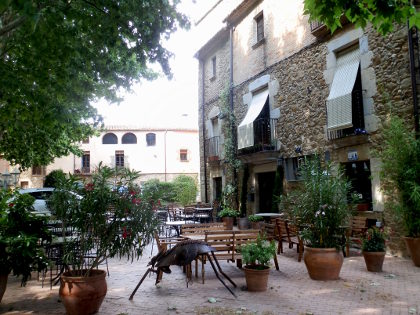 Corça is a little bit of a hidden gem situated just outside La Bisbal d'Emporda. This is the third or fourth walk from Corça for our blog, but it's still a super-charming village off the beaten track as far as tourism goes, with honey-stone houses, archways and nooks and crannies that wouldn't look out of place in the Cotswolds or the Dordogne. Yet it's so easy to miss. As is so common here, the main road, full of travellers rushing from Girona to the coast, skirts by leaving no impression of centre.
Corça is a little bit of a hidden gem situated just outside La Bisbal d'Emporda. This is the third or fourth walk from Corça for our blog, but it's still a super-charming village off the beaten track as far as tourism goes, with honey-stone houses, archways and nooks and crannies that wouldn't look out of place in the Cotswolds or the Dordogne. Yet it's so easy to miss. As is so common here, the main road, full of travellers rushing from Girona to the coast, skirts by leaving no impression of centre.
So we're back to fill in a little gap heading towards Rupia with views across the plain to the neighbouring villages and out towards the Isles Medes in the distance.
The entrance to the older part of the village is just off the main Bisbal-Girona road where from the rush of traffic on the main road, we emerge in a village placa shaded by plane trees with a children's playground just besides a small stream. There's some parking here, but we normally park just outside on the main road and walk in past the seemingly sunken cottages and school. The playground is buzzing with the noise of children and mum's but the small main bar is quiet and empty.
 We're mainly after the walk today so we skip the centre of the village and navigate along the lanes by the old village defensive wall crossing in and out of the old gate arches. At the top of the village we follow the sign towards the Camp de Futbol along a road of stone terrace cottages that look as if they could be twinned with Bibury. The road reaches a small chapel and we turn to the right up the road along a small track climbing gently.
We're mainly after the walk today so we skip the centre of the village and navigate along the lanes by the old village defensive wall crossing in and out of the old gate arches. At the top of the village we follow the sign towards the Camp de Futbol along a road of stone terrace cottages that look as if they could be twinned with Bibury. The road reaches a small chapel and we turn to the right up the road along a small track climbing gently.
The noise of music and a marquee tent tell us we're just passing a colonies house. In Spain, it's extremely common for schools to arrange visits to different parts of the country for casal or colonies with children staying in special centres - usually old farmhouses - in the country with a range of outdoor activities. In summer, with the long three-month holidays, many children get a week or two at the same colonies houses either just for the fun of it, or often taking part in sports, music or learning languages.
Our track continues upwards before turning right past an overgrown field with cows hiding among the bushes. If you're used to walking in England where every route seems to go through a field with cows, you have to appreciate that cows aren't that common by the coast - you see them more in the hills towards the Pyrenees - so it's a little surprising to see them here and hidden in amongst the shrubs.
The track turns to the left and we follow the signpost towards Rupia. From the hillside we can look out and see six or seven villages in the distance - small huddles of buildings nestled around the church - Ultramort, Casavells, Matajudaica closer to us and then further out to Llabia and the church of Palava standing tall. We also get to glimpse the Castell d'Emporda and in the distance we can see the estates of L'Estartit and the tops of the Islas Medes.
The wheat in the fields as we walk is not so dry that's it's almost magnolia in colour despite just being the first of June. The path though continues along the hedgerows towards Rupia, but rather than go to the village itself, we shorten the route past an equestrian centre before meeting the road we took on our last walk in this area.
As we get back to the village it's gone quiet. A dad and his son are racing through the empty streets, but the playground by the placa is empty as Corça goes back to being another sleepy hidden village.
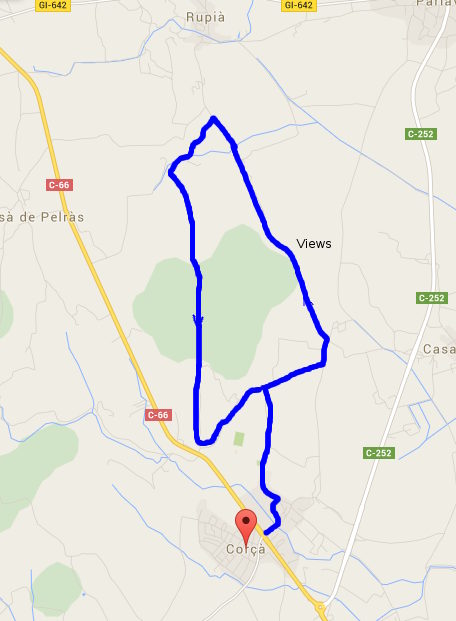
Rupit
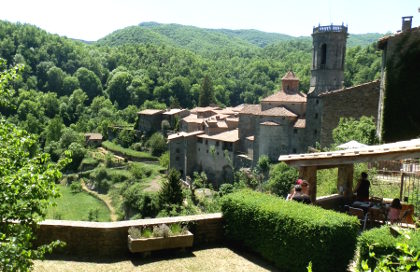 Rupit is a small village situated almost centrally between Girona, Vic and Olot isolated in the hills above the barrage lakes like the Panta de Sau of the river Ter. It had been recommended to us several times by different people, however, the relatively remote position - it's about 26km from Olot or about 30km from Vic with one road in or out - meant that we hadn't found an opportunity to visit. Taking advantage of the May sun, we discovered it really is a jewel comparable to the best Catalan villages like Besalu, Pals or Peratallada and well worth the journey.
Rupit is a small village situated almost centrally between Girona, Vic and Olot isolated in the hills above the barrage lakes like the Panta de Sau of the river Ter. It had been recommended to us several times by different people, however, the relatively remote position - it's about 26km from Olot or about 30km from Vic with one road in or out - meant that we hadn't found an opportunity to visit. Taking advantage of the May sun, we discovered it really is a jewel comparable to the best Catalan villages like Besalu, Pals or Peratallada and well worth the journey.
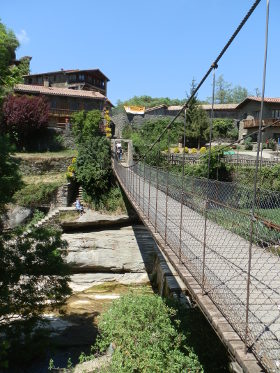 We've included the route we walked, though in practice this was more of a visit and explore than an actual walk. However, the area is full of interesting looking footpaths and geography - like the cingles cliffs (escarpments) of Collsacabra and rivers and streams that drain into the Ter, and the extinct volcanoes. The village is at 822m, so relatively high in the hills with cols at 1000m at the entrance and exit to the plain - both cols giving excellent views across the countryside below. The village was also busy with visitors including several walking groups and we noticed there is camping and accommodation nearby for a longer stay.
We've included the route we walked, though in practice this was more of a visit and explore than an actual walk. However, the area is full of interesting looking footpaths and geography - like the cingles cliffs (escarpments) of Collsacabra and rivers and streams that drain into the Ter, and the extinct volcanoes. The village is at 822m, so relatively high in the hills with cols at 1000m at the entrance and exit to the plain - both cols giving excellent views across the countryside below. The village was also busy with visitors including several walking groups and we noticed there is camping and accommodation nearby for a longer stay.
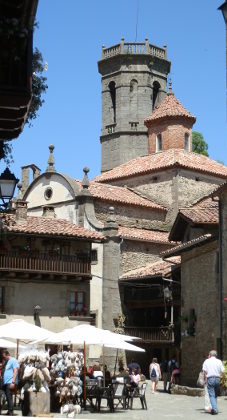 The journey really starts in the car and we drove through the valley by Angles, close to Cellera de Ter which marks the exit of the river Ter from the hills with some huge artificial lakes. We knew Rupit was to our right, but it's not until we got to Sant Esteve en Bas, about 4km from Olot that we reach the road up to Rupit. The drive climbs steadily, winding up until we get over the Coll de Condreu (1010m) and onto the top. The road was quiet - one pro-cyclist doing some hill training - so we were a little suprised by the number of cars and buses in the large car park at Rupit village.
The journey really starts in the car and we drove through the valley by Angles, close to Cellera de Ter which marks the exit of the river Ter from the hills with some huge artificial lakes. We knew Rupit was to our right, but it's not until we got to Sant Esteve en Bas, about 4km from Olot that we reach the road up to Rupit. The drive climbs steadily, winding up until we get over the Coll de Condreu (1010m) and onto the top. The road was quiet - one pro-cyclist doing some hill training - so we were a little suprised by the number of cars and buses in the large car park at Rupit village.
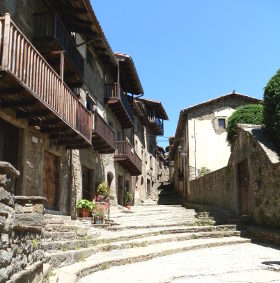 The first sense of the village was looking to the houses perched under and on rock-sides and the river running clear over sheets of rocks down into the heart of the village. To get to the centre, the access route is over a small wire-and-wood pedestrian suspension bridge that is limited to 10 people at a time, as it sways and bounces as we walk over the small river below.
The first sense of the village was looking to the houses perched under and on rock-sides and the river running clear over sheets of rocks down into the heart of the village. To get to the centre, the access route is over a small wire-and-wood pedestrian suspension bridge that is limited to 10 people at a time, as it sways and bounces as we walk over the small river below.
On the other side of the bridge, step lead up to the narrow main road through the village and rows of old 17th Century houses built in grey stone reminiscent of a remote alpine village. The road only has two or three junctions, so we explore a little, following the path up into the higher parts of the village up steps cut into the rock past houses with geraniums and old wooden balconies sitting underneath a weathered rock outcrop.
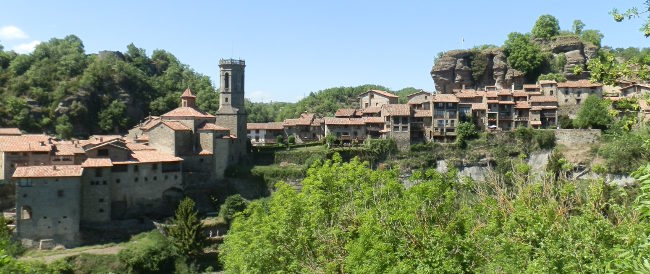 Gently weaving our way back to the heart of the village, the bars and cafes next to the church are filling up for lunch and walkers with proper hiking gear are returning from their morning trip. A number of different paths are marked, but its quite busy, so we follow the quieter route marked towards the Ermitage/Hermitage that can be seen on the opposite side of the valley. The path goes down to the river and a solid stone bridge and the water just tempts exploring, so rather than go direct to the Ermitage, we follow around the river to the right under a dripping waterfall and under rocky overhangs with shallow water playing over the rocks, only to find ourselves on the river underneath the suspension bridge for a different view of the town.
Gently weaving our way back to the heart of the village, the bars and cafes next to the church are filling up for lunch and walkers with proper hiking gear are returning from their morning trip. A number of different paths are marked, but its quite busy, so we follow the quieter route marked towards the Ermitage/Hermitage that can be seen on the opposite side of the valley. The path goes down to the river and a solid stone bridge and the water just tempts exploring, so rather than go direct to the Ermitage, we follow around the river to the right under a dripping waterfall and under rocky overhangs with shallow water playing over the rocks, only to find ourselves on the river underneath the suspension bridge for a different view of the town.
 We return back to the stone bridge and follow the path up through the woods to the Ermitage - a small chapel standing isolated in a field with the best views back over the village and also, from the far side, views to a stunning landscape of escarpment (cingle) cliffs and wooded valleys.
We return back to the stone bridge and follow the path up through the woods to the Ermitage - a small chapel standing isolated in a field with the best views back over the village and also, from the far side, views to a stunning landscape of escarpment (cingle) cliffs and wooded valleys.
From the chapel we turn to the right taking us away from the village and the path we came up, slowly navigating our way down to the river base below. In amongst the trees we see people sitting on the rocks above a waterfall (a Salt in Catalan is a waterfall) - the Salt de Sallent - which was also marked from the village.
 The waterfall is quite high as we can tell from the sound and the fact we can't see the base from the top. We climb down to see if there is a better view, but though we see smaller falls at the bottom, we don't quite see the full extent of the waterfall (online pictures suggest there is a viewpoint that we didn't find).
The waterfall is quite high as we can tell from the sound and the fact we can't see the base from the top. We climb down to see if there is a better view, but though we see smaller falls at the bottom, we don't quite see the full extent of the waterfall (online pictures suggest there is a viewpoint that we didn't find).
We return back through the woods, following the river emerging in the fields at the bottom of Rupit before taking the path through and archway and back into the village. With more time there would be much more to explore in this area. From Girona, Olot or Vic there are a lot of possibilities for things to see. Our drive back via Vic/Roda de Ter was also very picturesque with views of Collsacabra and then grand vistas to the mountains over the Plana de Vic.
Nearby: Sant Esteve d'En Bas (Olot) - Banyoles lakeside walk - Olot - capital of Garrotxa - Palol de Revardit to La Mota - Sadernes and river pools of St Aniol d'Aguja - Visit to Roda de Ter and Espinelves
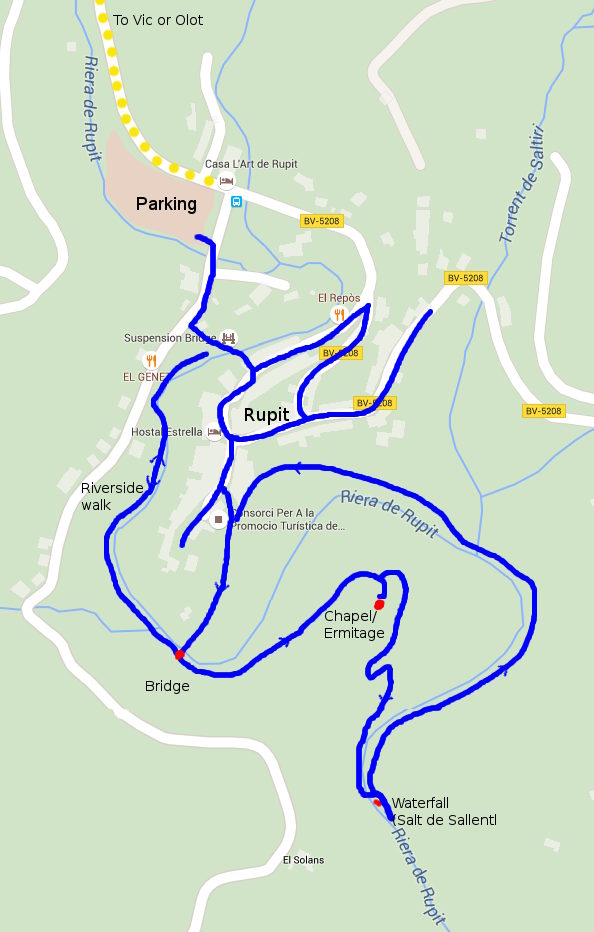
Spring sea mists on the Costa Brava
Just back from a walk across to Calella de Palafrugell and there is a beautiful sea mist rolling in from the sea. These early season mists are the result of the hot days starting, but the still relatively cool sea. The water warms the sea water lifting out a soft cool mist into the air. The can be quite mistical the way they roll in across the hills into otherwise bright sunny days.
Actually in Calella de Palafrugell, the town is wrapped in shroud of fog lifting across the sea into the bars and restaurants by the port. There were some disappointed holidaymakers around and no-one on the beach, probably completely unaware that if they went up to the top of the town, or a half mile inland the weather was completely different - perfect blue sky and one of the warmest days of the year so far.
The best thing about the fogs is that they keep the moisture in the air, so now in May, we have fields of green wheat just about to reach first harvest, and meadows of red poppies and all manner of flowers. So as a hint, early in the season, if the sea mist comes in, then head inland to the villages of the Costa Brava for the abundance of flowers and colour.

Tossa de Mar to Cala Llorell
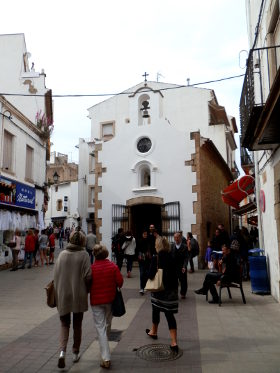 Tossa de Mar is one of the most popular destinations on the Costa Brava for holiday makers who come for the beach, the castle and old town walls that almost seem to tumble into the sea, and the busy bars and restaurants that run along the back of the two main beaches.
Tossa de Mar is one of the most popular destinations on the Costa Brava for holiday makers who come for the beach, the castle and old town walls that almost seem to tumble into the sea, and the busy bars and restaurants that run along the back of the two main beaches.
We've walked to the north (towards Cala Pola) and from the south on the GR92 from Lloret. This walk takes us down to Cala Llorell - the next beach to the south of Tossa de Mar.
A grumble for the GR92 from Lloret is the way the path passes across the top of some of the estates away from the beaches and coast itself. This can be for practical purposes, such as a lack of access for a beach framed by cliffs at one end, but also a number of the beaches have almost become private estates, fenced off and with a single point of access from the top with the route for walkers often a dull fence lined path through the hills at the back, without obvious diversions or routes down to the sea. Cala Llorell is case in point, and was one of the few beaches on the Costa Brava we still hadn't visited, so this was a bit of an explore south from Tossa.
 Our first problem was that Tossa de Mar on a May Day weekend was full of visitors, though the beaches were still pretty empty as we're not quite into swimming season yet. However, it did mean that the car parks were very busy, so not being afraid of a little walk, we parked on the outskirts by the sports centre and walked along the stream path into town.
Our first problem was that Tossa de Mar on a May Day weekend was full of visitors, though the beaches were still pretty empty as we're not quite into swimming season yet. However, it did mean that the car parks were very busy, so not being afraid of a little walk, we parked on the outskirts by the sports centre and walked along the stream path into town.
The roads through town were jammed - fine for browsing and strolling in the spring sunshine, but a little too slow for what we wanted to walk. So instead of taking the route to the old town and the castle and then up over the hidden pretty beach of Codolar and the Cami de Ronda, we nip through the quieter backstreets up to the top path.
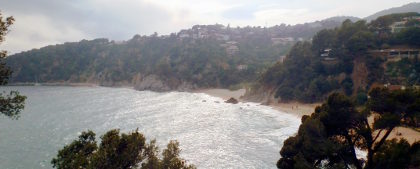 The top leads to some spectacular views from the Mirador de Codolar high on the cliffs over the town and there were plenty of people making the walk to take in the view. We carried on out though, joining the GR92 through the pine woods as we climb up and away from Tossa de Mar. The path is broad and gravelly and well used.
The top leads to some spectacular views from the Mirador de Codolar high on the cliffs over the town and there were plenty of people making the walk to take in the view. We carried on out though, joining the GR92 through the pine woods as we climb up and away from Tossa de Mar. The path is broad and gravelly and well used.
At a point just after the Xalet Vermell (the Red Chalet) - so called because it's a small red house and the only real feature on the path, the path splits. The GR92 turns to the right and the path down to Llorell continues downhill towards the sea. The path is fairly plain through the trees, but you have to be careful to keep to higher paths to the right - marked with arrows - as the routes down to the left are all dead ends.
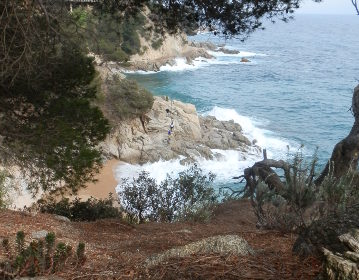 The path emerges into the campsite of Camping Cala Llevado which takes up a huge part of the hillside. In fact the campsite looks excellent with large amounts of terraced spaces and some quite luxury looking wood cabins around. To get down to the beaches though you have to walk on the roads through the campsite. In May this is not a problem, but in the height of summer, access may be more restricted for non-campers - something to check.
The path emerges into the campsite of Camping Cala Llevado which takes up a huge part of the hillside. In fact the campsite looks excellent with large amounts of terraced spaces and some quite luxury looking wood cabins around. To get down to the beaches though you have to walk on the roads through the campsite. In May this is not a problem, but in the height of summer, access may be more restricted for non-campers - something to check.
For our initial path we just head straight down for the first beach, down a long stretch of steps marked out with wood to a very small (and in summer naturist) beach at the bottom. All the way back up and then around the road to the pretty double-bayed beach of Cala Llorell. This beach is backed by a beach-club bar with an estate of houses dotted around the hillside to the back feeling like a private club-type resort. The sand is the same gritty sand of Lloret and Tossa and is split by a rocky outcrop in the middle. We could see a third smaller beach at the far end with a walkway around the cliff, but didn't go that far around.
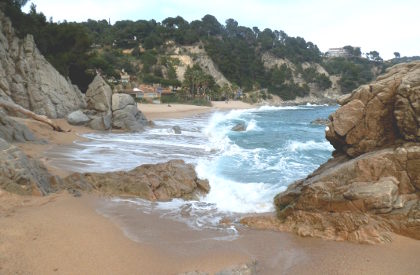 Coming back we took the main campsite road up to the top and the main entrance (just opposite a rugby ground). This is back to the GR92 which for this part across the top of the campsite follows the main Lloret to Tossa road. On the first path off, the GR92 turns into the woods and after a while we find ourselves back at the Xalet Vermell.
Coming back we took the main campsite road up to the top and the main entrance (just opposite a rugby ground). This is back to the GR92 which for this part across the top of the campsite follows the main Lloret to Tossa road. On the first path off, the GR92 turns into the woods and after a while we find ourselves back at the Xalet Vermell.
Instead of repeating the route back, we take the first left after the Chalet down into the woods, following the stream making for a very pleasant descent through the woods with new leaves on the trees. Above us we can see the Torre de Moriscos - the Moor's Tower. The path emerges at the back of the main car parks for Tossa close to the bus station and would be an option for walking avoiding the centre of Tossa and the route by the cliffs.
See also: Tossa de Mar north to Cala Pola - Lloret's Platja de Boadella, Platja de Santa Cristina and The Fence - Blanes, Lloret de Mar, Tossa de Mar by GR92 - Sant Grau and Cadiretes near Tossa de Mar - Llagostera to Sant Llorenç - Sant Feliu de Guixols Pedralta
Swimming and beaches of Tossa de Mar
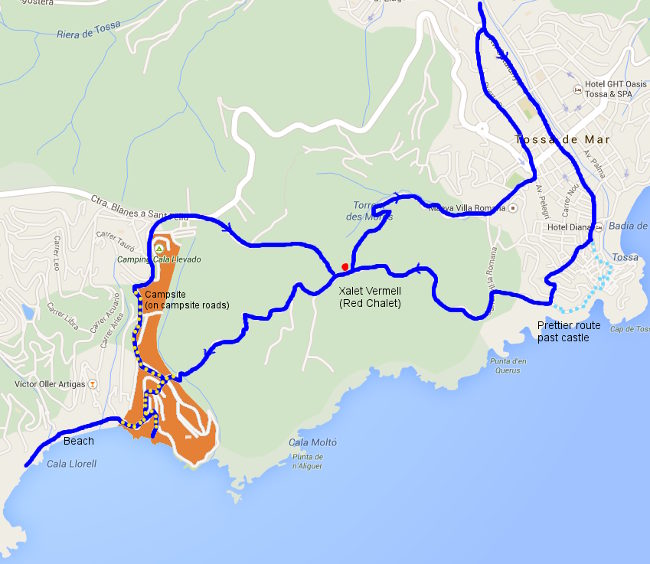
Roses and Roses Ciutadella
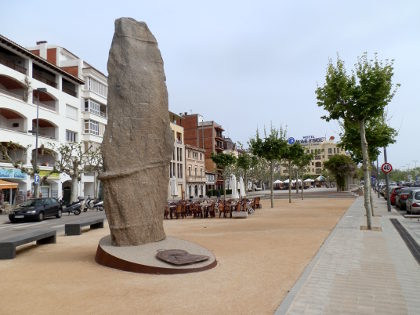 Roses is the main tourist town of the northen part of the Costa Brava sitting with one half of the town reaching into the Cap de Creus, and the other side stretching around the beach of the long bay of the Gulf of Roses to the modern marina-towns of Sant Margarida and Empuriabrava. With easy access to Figueres and the French border, the town is extremely popular with French visitors, or overland travellers from Germany or the Netherlands.
Roses is the main tourist town of the northen part of the Costa Brava sitting with one half of the town reaching into the Cap de Creus, and the other side stretching around the beach of the long bay of the Gulf of Roses to the modern marina-towns of Sant Margarida and Empuriabrava. With easy access to Figueres and the French border, the town is extremely popular with French visitors, or overland travellers from Germany or the Netherlands.
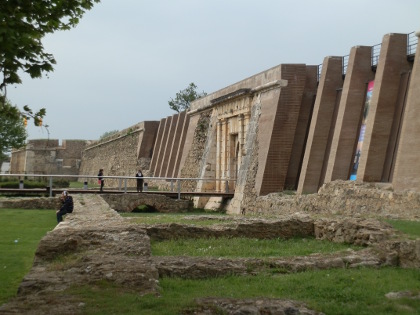 The location is fabulous with a big town beach, hidden chic beaches at Canyelles, views down the bay to the south, a large port, and views (on a clear day you can see the Pyrenees). However, the modern town itself though a bustling holiday town, can feel a little uninspiring if you are looking for nestling fishermen's cottages and historic wending streets. But there is a reason for that, which is deeply entwined with the history of the town and the more you know the history, the more intriguing the town becomes.
The location is fabulous with a big town beach, hidden chic beaches at Canyelles, views down the bay to the south, a large port, and views (on a clear day you can see the Pyrenees). However, the modern town itself though a bustling holiday town, can feel a little uninspiring if you are looking for nestling fishermen's cottages and historic wending streets. But there is a reason for that, which is deeply entwined with the history of the town and the more you know the history, the more intriguing the town becomes.
The reason why Roses lacks a medieval type centre is because the town moved in the 17th and 18th centuries. The remains of the medieval town of Roses can actually be found completely inside the fortified walls of the Ciutadella of Roses - the large fort that you pass on the way into the town from Figueres.
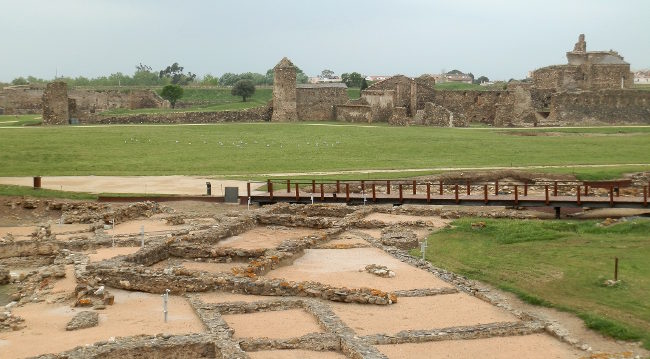 Roses actually has a history that stretches back to the Ibers, then as a Greek colony, linked to Empuries further south, before the Roman's moved in. The Roman's built at Roses, but also left a defensive fort above the town. In medieval times Roses became more important as a centre of trade and grew with a full town wall with defensive towers.
Roses actually has a history that stretches back to the Ibers, then as a Greek colony, linked to Empuries further south, before the Roman's moved in. The Roman's built at Roses, but also left a defensive fort above the town. In medieval times Roses became more important as a centre of trade and grew with a full town wall with defensive towers.
Roses defensive position made it an important strategic location and as pirate raids increased in the 16th Century as the Ottomans, known as the Barbary pirates, under Barbarossa, it became clear that the medieval walls were no longer considered adequate to safeguard the town from cannons on land or from sea.
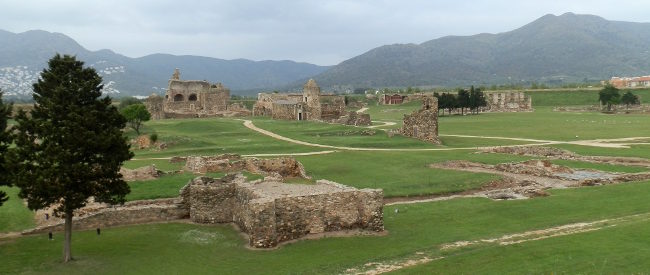 So instead of starting again, the town was enveloped in the massive earth and fortifications that can now be seen at Roses Ciutadella. Completed in 1553, the medieval town remained with streets, houses and still with it's original walls but now completely within the fortress. In actual fact the fortress is about double the size of the town inside, which should give a feeling of scale both of the building as it is now, but also the enormous effort needed to create the fortifications.
So instead of starting again, the town was enveloped in the massive earth and fortifications that can now be seen at Roses Ciutadella. Completed in 1553, the medieval town remained with streets, houses and still with it's original walls but now completely within the fortress. In actual fact the fortress is about double the size of the town inside, which should give a feeling of scale both of the building as it is now, but also the enormous effort needed to create the fortifications.
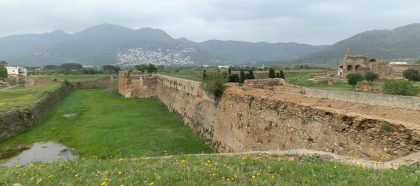 The Ciutadella was part of a wider defensive network of towers and castles that can still be seen around the town. The Ciutadella didn't just house the town, it also held a garrison for soldiers and progressively parts of the population moved outside the town walls.
The Ciutadella was part of a wider defensive network of towers and castles that can still be seen around the town. The Ciutadella didn't just house the town, it also held a garrison for soldiers and progressively parts of the population moved outside the town walls.
The Ciutadella became part of the ebb-and-flow of the wars and power struggles between France and Spain. Starting with the Catalan Revolt when Catalonia became independent under French protection), and ultimately into the War of Spanish Succession, revolutionary France, and then into the era of Napoleonic conquest. At the end of the Napoleonic era, the Ciutadella and the town inside were destroyed, leading to the full development of modern Roses along the bay.
 The evidence for this remarkable history is through the town, though it means the modern centre feels functional rather than pretty. The fortifications and older buildings can be seen dotted around, such as the Castell de la Trinitat above the port or various towns situated on the hills at the back of Roses (Puig means hill).
The evidence for this remarkable history is through the town, though it means the modern centre feels functional rather than pretty. The fortifications and older buildings can be seen dotted around, such as the Castell de la Trinitat above the port or various towns situated on the hills at the back of Roses (Puig means hill).
However, inside the Ciutadella walls, it is still possible to see the remains of the old Roses. Archeologists have discovered the remains of the Greek and Roman Roses - also inside the Ciutadella, but outside the Medieval town, while parts of the Medieval walls and towers still exist within the Ciutadella itself.
Visiting the Ciutadella costs €4 for entry which includes a small museum with artifacts from Greek and Roman times. For visitors, it's worth going to the museum first to get a sense of the multiple layers of history and how they overlap within the same site. Entering into the Ciutdella from the front, the old town is to the left, with walls and towers still visible and a clockwise tour around the walls will give an ample overview of the scale and sense of what it would have been like to live in a town with a wall going up around the outside.
Neighbouring walks
Llança - Cadaques and Port Lligat - Port de la Selva - Sant Pere de Rodes - Figueres and Castell de Sant Ferran - Roses - Canyelles beaches to Cap Falconera - Cadaques to Roses - La Jonquera to Fort de Bellegarde (France) - Peralada - Castello d'Empuries
Dia de Sant Jordi in Palafrugell
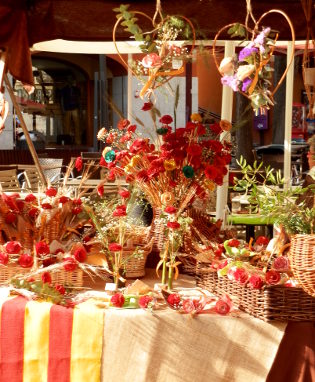 Sant Jordi (Saint George's day) on the 23rd April is probably my favourite Catalan festival. Unlike England, which shares the same day, a Catalonian Dia de Sant Jordi is a celebration of love and literature.
Sant Jordi (Saint George's day) on the 23rd April is probably my favourite Catalan festival. Unlike England, which shares the same day, a Catalonian Dia de Sant Jordi is a celebration of love and literature.
The tradition is that a man gives his partner a rose, and she gives him a book. In practice everyone gives each other books and roses. The book part is relatively new - only started in 1929, but comes about because the 23rd April commemorates Shakespeare's and Cervantes birth day and, now for locals, the death of probably the most famous modern Catalan writer Josep Pla (of Palafrugell...). In 1996 23rd April became the first international book day.
The combination of literature, roses and romance is delightful. Sellers put stalls out on the streets decorated with the yellow and red of the Catalan flag and it seems to be a day that everyone is smiling. Much better than the sickly sweet Valentines day with it's excess of chocolate and bad taste.
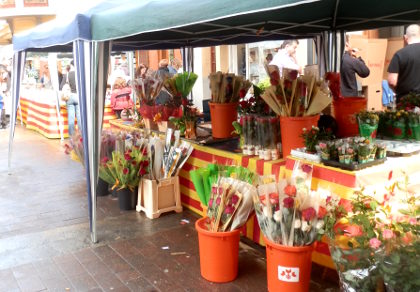 The other famous Catalan festival (besides the commemoration of the Diada in September) is the Nit de Sant Joan - a hugely noisy festival of fireworks and bangers for the midsummer's night (23rd-24th June). I'm afraid I always found this too noisy and wild, particularly in Barcelona where the bangs continue all night,
The other famous Catalan festival (besides the commemoration of the Diada in September) is the Nit de Sant Joan - a hugely noisy festival of fireworks and bangers for the midsummer's night (23rd-24th June). I'm afraid I always found this too noisy and wild, particularly in Barcelona where the bangs continue all night,
Palafrugell itself, is the central town for the municipality that includes the coastal towns of Calella de Palafrugell, Llafranc and Tamariu. While the coastal villages are tourist heaven, Palafrugell itself is a working town, once the largest cork producer in the world and the active centre for locals from many of the villages including Pals and Begur to the north. It has character without being pretty in itself and a huge Sunday market that stretches through half the streets of the town to the north. It can feel strangely quite dead during lunchtime for the long mid-day break, but very busy in the evening with bars and occasionally music and sardanes in the evenings. Visitors will probably see the supermarkets on the road that runs around to beach-side villages, but it's worth visiting to get a taste of real Catalan life, though the one way system can be a little confusing for newcomers trying to find the centre.
Gardens of Cap Roig - Palafrugell - Begur - Festa d'Indians - Mont-ras to Calella de Palafrugell and Llafranc - Palafrugell, Tamariu, Begur residential and Esclanya
Tamariu - Aigua Xelida
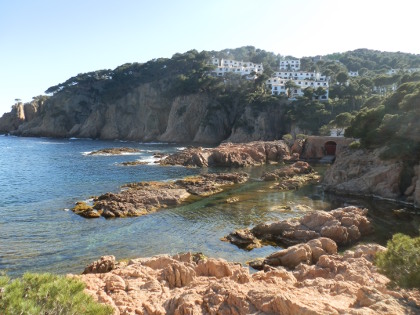 On the north side of Tamariu in the direction of Aiguablava, the hillside is filled by an estate of luxury villas and a private mini-village that runs down to the tiny beach of Aigua Xelida. Recently they have improved the paths in the area and it's now easier to walk close to the cliffs above some of the tiny rocky bays with some spectacular scenery. Be warned, there are lots of steps on this particular walk - more than 200 in each of the two upward stretches.
On the north side of Tamariu in the direction of Aiguablava, the hillside is filled by an estate of luxury villas and a private mini-village that runs down to the tiny beach of Aigua Xelida. Recently they have improved the paths in the area and it's now easier to walk close to the cliffs above some of the tiny rocky bays with some spectacular scenery. Be warned, there are lots of steps on this particular walk - more than 200 in each of the two upward stretches.
Access is easy from Tamariu following the sign posts to Aigua Xelida (or Gelida?) slightly out of town and up the hill into the estate. At the top roundabout the road runs down hill to an area where it splits in two with easy parking on both sides.
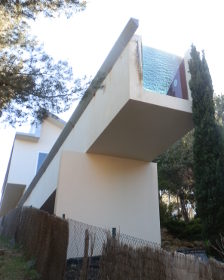
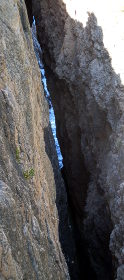 The main access to Aigua Xelida beach is straight in front of us, down through the trees on a dirt path full of soft pine needles. However for this walk we're making a slightly different loop, so we take the cutting next to the white house down to the next road. The house itself is a bit unusual - at the end of the cutting and when we look back we can see the glass end of a long thin pool - it must be swimming with a view.
The main access to Aigua Xelida beach is straight in front of us, down through the trees on a dirt path full of soft pine needles. However for this walk we're making a slightly different loop, so we take the cutting next to the white house down to the next road. The house itself is a bit unusual - at the end of the cutting and when we look back we can see the glass end of a long thin pool - it must be swimming with a view.
We follow the road around to find the entrance to the cliffside path. This has recently been done up and the paths are now indicated with yellow painted wooden markers. We are actually high above a small bay and a couple of small islands with seagulls nesting on the cliff face. The path curls around the top giving unspoilted coastal views before running slightly off the cliff edge and round a small gully. This small gully is a sea-hole, a long crack in the cliffs that allows you to see down to the sea below, no more than about a metre wide all the way down. With a suitable wind, the gap makes the noise of the sea echo and moan through the gap almost like a voice.
 We now follow the path down to the edge of a small rocky bay and then around a path with low growing pines reaching out blocking our way as fun obstacles to scramble around. Around the back of a fisherman's house we follow the steps down to the main and very tiny beach at Aigua Xelida. The water though is crystal clear. The beach itself has a small natural stream with fresh water running across the rocks of the beach directly into the sea. The first time we visited this bay a while ago, was on a cold January day, and the stream had frozen (Xelida=iced) with icicles dangling from the moss.
We now follow the path down to the edge of a small rocky bay and then around a path with low growing pines reaching out blocking our way as fun obstacles to scramble around. Around the back of a fisherman's house we follow the steps down to the main and very tiny beach at Aigua Xelida. The water though is crystal clear. The beach itself has a small natural stream with fresh water running across the rocks of the beach directly into the sea. The first time we visited this bay a while ago, was on a cold January day, and the stream had frozen (Xelida=iced) with icicles dangling from the moss.
From the bay, we now head upwards. It's mostly steps now to the top of the cliff on the north side. The path is good though and well maintained with a small wall for guidance. The path runs next to a private village type estate which means that if you do go up this way, the only walking route back to the start (without retracing your steps), is the loop we're doing.
 The views from the path are excellent back to the beach and coves, slightly hidden behind the trees. At the top we meet one of the roads into the estate. This is very much luxury estate territory with big houses in big mature gardens overlooking the sea. The road technically is a dead end, but for walkers there are two options.
The views from the path are excellent back to the beach and coves, slightly hidden behind the trees. At the top we meet one of the roads into the estate. This is very much luxury estate territory with big houses in big mature gardens overlooking the sea. The road technically is a dead end, but for walkers there are two options.
The first is to take one of the cuttings to the left down through the houses to a path that runs closer to the cliffs. This is relatively short though and it's 100 steps back up to the top. This then gets added to the next 100 steps as we head up and out on the wooden steps that run between the houses up the hill (next to the red house).
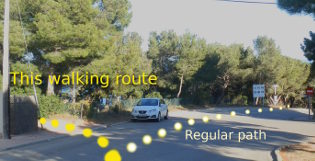 At the top we stay with an estate road that curls to a track. At the point the track meets the road there is a cutting down towards Tamariu. But instead we stay on top and follow the road and path back to the car.
At the top we stay with an estate road that curls to a track. At the point the track meets the road there is a cutting down towards Tamariu. But instead we stay on top and follow the road and path back to the car.
See also: Palafrugell, Tamariu, Begur residential and Esclanya - Far de Sant Sebastia (Llafranc) to Tamariu - Fornells and Aiguablava walk (GR92)
For swimming: Swimming at Aigua Xelida (Tamariu) - Swimming at the beach at Tamariu
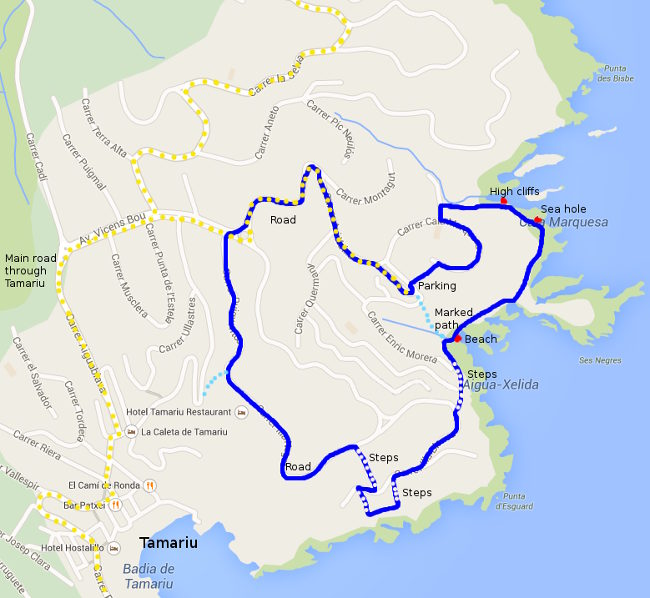
Palol de Revardit to La Mota
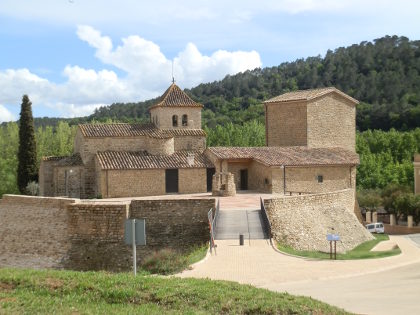 Situated on the way to Banyoles, Palol de Revardit is a small, pretty village/hamlet with a newly restored castle set among the hills behind Girona. Access to the village is from the C66 dual carriageway between Girona and Banyoles.
Situated on the way to Banyoles, Palol de Revardit is a small, pretty village/hamlet with a newly restored castle set among the hills behind Girona. Access to the village is from the C66 dual carriageway between Girona and Banyoles.
This walk takes us from the village into the hills and up to the hilltop ridge at La Mota which looks over the countryside to the Pyrenees and out to the sea on one side, and across to Girona on the other. The walk up to La Mota is clearly marked from Palol de Revardit, the walk down is a little less clearly marked.
W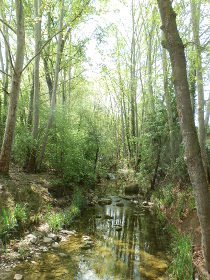 e park by the castle at Palol de Revardit. The village is quite small with probably less than a hundred houses and a small ajuntament, but the castle has recently been renovated and the village is very well kept. After a little explore and getting our bearings, we find the signpost marked for the route to La Mota (4.2km). The first part of the walk is along a small village lane that crosses a small stream before a gentle climb to the hills. Though we're on the road it's quiet as the roads only lead to the hills and local farms.
e park by the castle at Palol de Revardit. The village is quite small with probably less than a hundred houses and a small ajuntament, but the castle has recently been renovated and the village is very well kept. After a little explore and getting our bearings, we find the signpost marked for the route to La Mota (4.2km). The first part of the walk is along a small village lane that crosses a small stream before a gentle climb to the hills. Though we're on the road it's quiet as the roads only lead to the hills and local farms.
Being spring, the morning was dotted with rain but as we arrived at Palol, the afternoon broke out into a warm bluesky dotted with clouds and it feels like everything is growing. The trees have that fresh verdent green of new leaves and the flowers are filling the meadows.
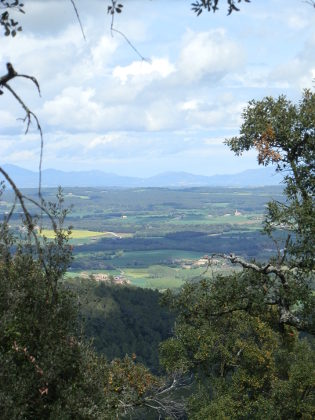 After a short climb past one of the old farms used for tourisme rural, the sign posts take us of the road and up a broad track into the hills. We have the first sound of a cuckoo to accompany us as we follow the track up through the woods. The ground is drying under our feet as we walk and it's a steady slightly humid climb in among a mix of pines and deciduous trees.
After a short climb past one of the old farms used for tourisme rural, the sign posts take us of the road and up a broad track into the hills. We have the first sound of a cuckoo to accompany us as we follow the track up through the woods. The ground is drying under our feet as we walk and it's a steady slightly humid climb in among a mix of pines and deciduous trees.
The track is broad and pleasant without having too many highlights and after around 2km emerges at a set of meadows just below Sant Marti de la Mota church, perched on the hill ahead of us. The path splits at this point and we could head directly to Els Refugis de la Mota, but instead take the road to the church we can see, part a newly renovated masia with commanding views over plains below. The road does a down and up, and we emerge close to the chapel/church of Sant Marti. The church, like many more isolated ones, is connected to a farmhouse and we meet the owners who point out the views out towards the sea in the distance.
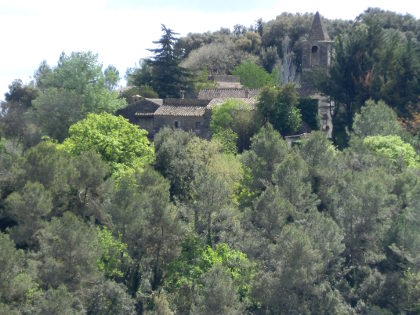 We now follow another road along the ridge at the top of the hill. To begin with all the views are to the north, but as we come close to a small urbanisation the views open up across to Girona, with the cathedral clearly visible from where we are. The views extend all around, to the ancient former volcano above Canet d'Adri and up to the Rocacorba mountains behind us.
We now follow another road along the ridge at the top of the hill. To begin with all the views are to the north, but as we come close to a small urbanisation the views open up across to Girona, with the cathedral clearly visible from where we are. The views extend all around, to the ancient former volcano above Canet d'Adri and up to the Rocacorba mountains behind us.
As is common with many of these highpoints, there is a dolmen close to the top. The sign says the grave is 5,000 years old, but these ancient burial sites are never quite as impressive a you might expect.
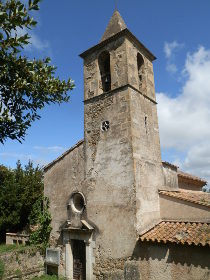 The route down follows a track just behind a small playground for the urbanisation that runs under the urbanisation hill on the right, with a stream or gully turning into a valley to the left. It wasn't entirely clear if the track was the route to start with but it was fine - more surprising was that someone had just driven it from the look of the tracks, despite the mud and heavy pot-marks.
The route down follows a track just behind a small playground for the urbanisation that runs under the urbanisation hill on the right, with a stream or gully turning into a valley to the left. It wasn't entirely clear if the track was the route to start with but it was fine - more surprising was that someone had just driven it from the look of the tracks, despite the mud and heavy pot-marks.
The rain had left the track muddy in contrast to the dry track we came up, and from time to time we have to negotiate slippy puddles on the way down, but again it's more pleasant wood-walking without stand-out things to see.
Towards the bottom we cross a stream on stepping stones and pass a couple of old farms being rennovated before walking past tree plantations in the bottom of a shallow valley. We emerge from the path at the Veinet de Can Padres. We were trying to get back to Palol directly, but didn't see a path. Unfortunately the connection from Can Padres to Palol is road all the way - and a newly refurbished road, but there are only three or four cars.
The road takes us above Palol with views of the village and its surrounding, before turning off and then down back towards the castle.
Nearby: Serinya and Illa del Fluvia - Banyoles lakeside walk - Sant Miquel de Fluvia - Bascara - horses, fords and lost - Cervia de Ter - Canet d'Adri - Celra, Juia and the Castle of Palagret - Roman fort at St Julia de Ramis (Girona)
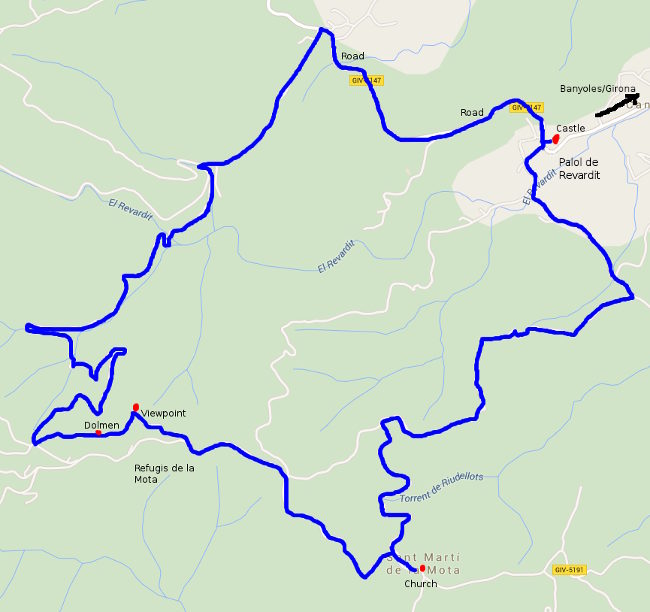
MIC 2015 Football Tournament
Easter's back with us and the Mediterranean International Cup has returned with first matches on the 31st March/1st April and finals on Saturday and Sunday (4th/5th April). This is a world-class youth football competition held in the Costa Brava every Easter which attracts the youth and development players of Europe's leading football clubs and clubs from around the globe. Neymar, Messi and a huge bunch of other famous Spanish and other football stars played as part of their development from juniors to senior players.
Matches are organised by age. Full schedule (with locations is here: http://www.micfootball.com/en/tournament/results.html)
Under 19s are playing at Cassa de la Selva, Lloret de Mar, Sta Coloma de Farners and Tossa de Mar.
- Teams include: FC Barcelona, Villarreal, Real Madrid, Atletic Club de Madrid, Levante
Under 16s at Llagostera, Hostalric, Sils, Sant Feliu de Guixols, Vidreres.
- Teams include: Espanyol, New York, Scarborough, Villarreal, Yokohama, Valencia, Sevilla
Under 14s at Palafrugell, Begur, Calonge, Mont-ras, La Bisbal, Platja d'Aro.
- Teams include: Barcelona, Real Madrid, Porto, Inter Milan, Northern Ireland, Los Angeles (USA), Espanyol, Sydney (Australia), Getafe.
Under 11s at L'Escala, L'Estartit, Torroella, Begur and Palamos.
- Teams include: Barcelona, Manchester United, Manchester City, Liverpool, Brentford, Ajax, Real Madrid, Valencia, Espanyol, Bogota (Colombia), Getafe, Los Angeles
Entrance to the matches is free as far as I'm aware (certainly for the younger categories).
Cassa de la Selva
 From Girona Airport to the Costa Brava for Sant Feliu de Guixols, Palamos and Palafrugell, after passing through the small village of Ruidellots de la Selva, the C66 road skirts past the larger town of Cassa de la Selva. The town is on the flat just under the Gavarres with a fabulous if demanding cycle route over the hills behind to La Bisbal.
From Girona Airport to the Costa Brava for Sant Feliu de Guixols, Palamos and Palafrugell, after passing through the small village of Ruidellots de la Selva, the C66 road skirts past the larger town of Cassa de la Selva. The town is on the flat just under the Gavarres with a fabulous if demanding cycle route over the hills behind to La Bisbal.
Being set back from the road, it's very easy just to drive by looking only at the industrial estates on the outside, but it is a traditional Catalan town with a pleasant town centre. Our aim is a gentle walk into the rolling farmland behind the town itself, rather than into the heights of the Gaverres. The early part of this walk has some views towards Montseny, though it was a day with rain in the air so not clear enough for good photos. The second half of the walk after crossing the GI664 has more expansive views to Girona and the mountains. An unexpected feature was the Park de les Arts Contemporanies - a large open air museum with modern sculpture. Unfortunately it was closed out of season but is a place to re-visit.
To start we park in one of the municipal car parks on the main inner road around the centre of Cassa. Cassa itself has an older part around the church and a more modern (1920s) area situated by the old Casino (a meeting place rather than a gambling den). We're not really visiting the town this time, though we do drift into the centre on the way back.
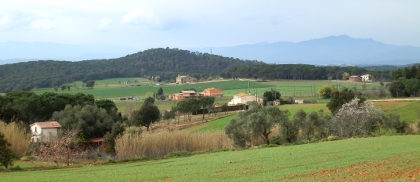 From the car park we go to the real start, just by a roundabout on the edge of the town. This is clearly marked with a signpost and we following the yellow-white markers for a local route. Initially we walk past a few industrial units towards farms, before turning up a track into the woods and up a hill. All OK, but not spectacular. At the top of the hill is a small water deposit with views across Cassa and down towards the mountains of Montseny (towards Barcelona). This is farming countryside with fields and woods and large isolated farm houses, rather than the dense alsina forests of higher up in the Gavarres.
From the car park we go to the real start, just by a roundabout on the edge of the town. This is clearly marked with a signpost and we following the yellow-white markers for a local route. Initially we walk past a few industrial units towards farms, before turning up a track into the woods and up a hill. All OK, but not spectacular. At the top of the hill is a small water deposit with views across Cassa and down towards the mountains of Montseny (towards Barcelona). This is farming countryside with fields and woods and large isolated farm houses, rather than the dense alsina forests of higher up in the Gavarres.
We cross the road that links Cassa to La Bisbal. This is a lovely cycling route for those who like hill climbs, rising up to 400m or so with a dramatic change in scenery as you leave the farmlands and reach more isolated and higher levels of the Gavarre hills, before coming down again to La Bisbal.
 Our walk continues past more farms. It's not completely isolated and in two of the houses, there seem to be family gatherings with lots of cars parked in the yard and the smell of barbequing sausages drifting in the wind. The view starts to open out and we find horse tracks all the path. We have views to the flashing telecoms tower in Girona and a grand vista which takes in Girona airport and the hills beyond. We pass one of the horse-riding centres sweeping under the hills to our right, then start our return journey just a little ahead of the official path, turning down past a tumble down masia into the woods.
Our walk continues past more farms. It's not completely isolated and in two of the houses, there seem to be family gatherings with lots of cars parked in the yard and the smell of barbequing sausages drifting in the wind. The view starts to open out and we find horse tracks all the path. We have views to the flashing telecoms tower in Girona and a grand vista which takes in Girona airport and the hills beyond. We pass one of the horse-riding centres sweeping under the hills to our right, then start our return journey just a little ahead of the official path, turning down past a tumble down masia into the woods.
Ahead of us the road splits. The signpost to the left says Cassa so we take that and end up at the back of the modern art park, where we can peek through the fence at the curious collection of mechanical and modern art sculptures. To find out more we make a brief diversion to the front, but it's closed at the moment - only open by appointment. Presumeably it will re-open during summer.
We then turn back to Cassa heading straight for the church and the pedestrianised shopping streets that are quiet and closed on Sunday afternoon. A slight mis-direction means that we miss the more modern part of Cassa with the Casino and instead end up at the car.
Other visits: Hostalric stroll - Caldes de Malavella - Via Ferrata at the Gorges de Salenys - Romanya de la Selva - Gavarres Montnegre and Montigalar - Santa Coloma de Farners - Llagostera to Sant Llorenç - Volca de la Crosa - Sant Dalmai (Girona Airport) - Ruta del Carrilet - Girona cyclepath to the coast
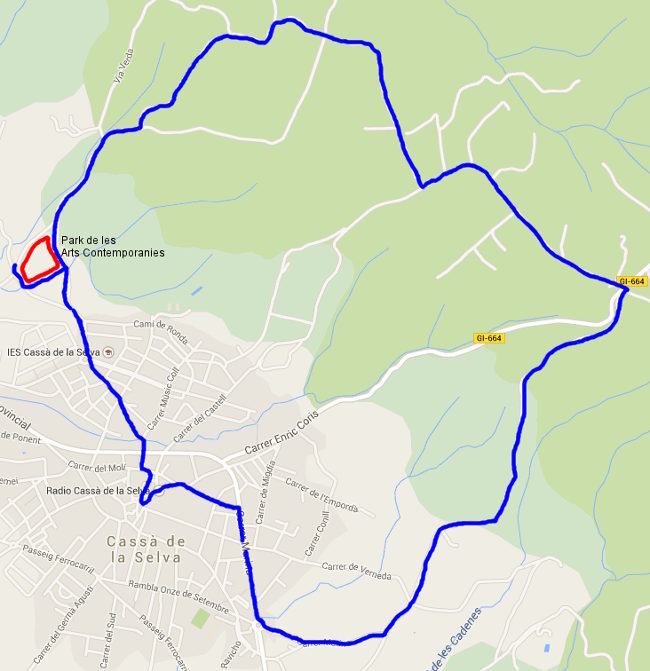
Sant Pere Pescador river Fluvia
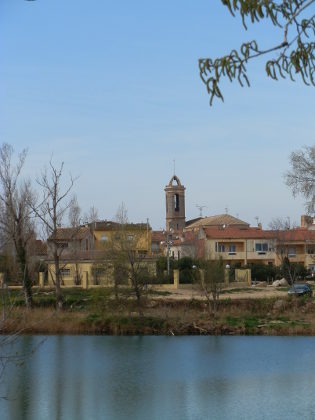 Sant Pere Pescador is a small town situated between L'Escala and Roses on the banks of the River Fluvia, not quite on the coast itself.
Sant Pere Pescador is a small town situated between L'Escala and Roses on the banks of the River Fluvia, not quite on the coast itself.
The northern side of the Fluvia runs into the Aiguamolls d'Emporda - a vast wetlands reserve for wild birds including storks and flamingoes. The southern side of the river connects to the long broad beach that carries on for about 7km down past Sant Marti d'Empuries.
The area is quite flat with lots of campsites and not much habitation otherwise. More inland, the countryside is flat with expanses of espallier orchards and fruit farms.
We parked just outside the town of Sant Pere Pescador, close to a tourist information centre just before the bridge across the river into town.
For this visit we didn't go into Sant Pere Pescador itself as we were more interested in the coastal scenery just south of El Fluvia - the north side is the Aiguamolls d'Emporda wetlands bird sanctuary.
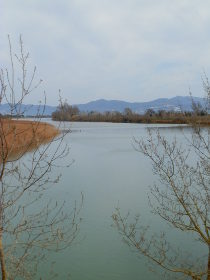 The path was then very easy to follow and entirely flat the whole way around.
The path was then very easy to follow and entirely flat the whole way around.
The day was a little overcast and greyish days with low scenery don't make for the best photos.
We walk firstly just following the river which is actually quite wide and in fact, with the reeds in the water, the birds and the low trees at times it felt like we could have been walking in the Fens or the East Anglian coast.
The main walk out along the river we could see cormorants on the water and collections of anglers parked and fishing on the other side of the river.
A queue of stand-up paddle-boarders on the river was the only sign of tourist type activities, though I guess in summer the area will be much busier and the whole area is full of campsites.
The river path eventually runs past fields of low sandy dunes with beach vegetation of grasses and low shrubs before reaching the beach where the Fluvia meets the sea (the Gola).
A small viewing platform allows you to get about 3m above the height of the land and though it doesn't sound much, because of the low level of the ground, the extra height opens up views to Roses and out to the Pyrenees in the background as well as providing vistas back along the river to Sant Pere.
The beach itself is long and broad - it runs 7-8km straight down towards Sant Marti d'Empuries - with soft sand underfoot.
The winter weather creates undulations in the sand so as we walk along the beach we're continually going up and down and with occasional soft patches, the walking is harder work than we expected.
We're not the only ones on the beach, but it is very sparsely populated. A few other Sunday afternoon walker and, ahead of us, someone testing out motorised paragliders taking off, making a short hop along the beach, then landing before repeating the exercise.
The beach runs at the back of a number of campsites, set back a little from the beach. Now, out of season, they are all closed up, but even in the height of summer, the sand is so broad that it would be difficult to imagine that it would get very crowded.
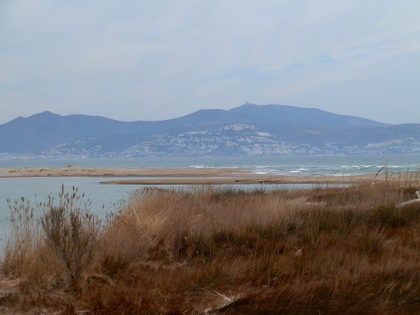 We come off the beach and follow a small path a little closer to the campsites, mainly to get off the sand, then by Camping Amfora we follow a strange wide boulevard past an isolated estate of villas back towards Sant Pere Pescador.
We come off the beach and follow a small path a little closer to the campsites, mainly to get off the sand, then by Camping Amfora we follow a strange wide boulevard past an isolated estate of villas back towards Sant Pere Pescador.
The aim was to see if we could connect to L'Armentera via the Bon Relax estates, but unfortunately the connecting path that we were hoping might exist doesn't exist. So instead we wander through the villas and strange set of high rise blocks of the Bon Relax estate.
These are the high rise blocks that can be seen from miles away and feel totally out of place in what otherwise is a low-height area. The estate also feels strangely disconnected - it's not by a town or village, it's not on the sea and there are no other buildings or industry nearby.
The path from Bon Relax to Sant Pere Pescador goes along the road for a short while and back to the car.
For walking, the stretch from the beach to Bon Relax could easily be skipped, just staying on the path closer to the Fluvia.
See also: Aiguamolls d'Emporda (Empuriabrava) - Escala, St Marti d'Empuries and beyond - Castello d'Empuries - Roses - Canyelles beaches to Cap Falconera - Roses and Roses Ciutadella - Bellcaire d'Emporda, Tor and Albons - Serinya and Illa del Fluvia - Sant Miquel de Fluvia
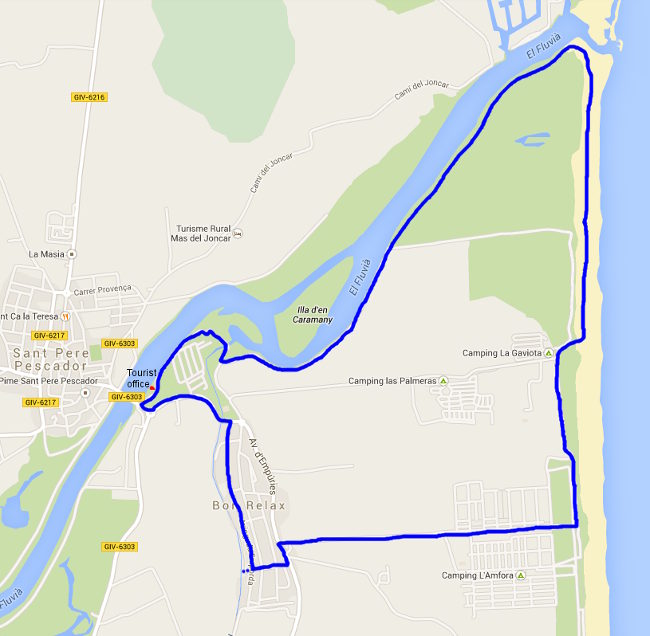
Palamos and carnival
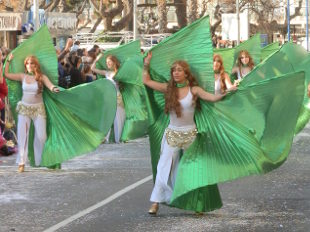 Palamos, like nearly all the Costa Brava towns has a large carnival procession to celebrate the coming of Lent where people dress up, dance and compete for the best show in town. In Catalonia, as with many European Catholic regions, carnival has developed into a grand tradition even though it was actually banned in Franco's time. The modern festivals are now enormous. Palamos had about 50 floats this year and the amount of work put into costumes and practicing dance routines is huge often with 40-50 dancers in matching outfits following a float blaring out their dance music.
Palamos, like nearly all the Costa Brava towns has a large carnival procession to celebrate the coming of Lent where people dress up, dance and compete for the best show in town. In Catalonia, as with many European Catholic regions, carnival has developed into a grand tradition even though it was actually banned in Franco's time. The modern festivals are now enormous. Palamos had about 50 floats this year and the amount of work put into costumes and practicing dance routines is huge often with 40-50 dancers in matching outfits following a float blaring out their dance music.
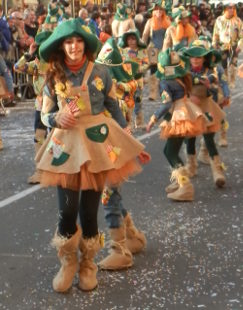 There are carnival processsions is most of the major towns (except for Palafrugell which has a Festa de Primavera at the end of May instead), but rather than having competing carnival processions, the festivities are often staged on different days in different places. This allows the carrossellers to attend more than one festival. For instance, floats from Sant Feliu de Guixols on a Friday would then visit Platja d'Aro or Palamos on the Saturday and then move to a different town on the Sunday.
There are carnival processsions is most of the major towns (except for Palafrugell which has a Festa de Primavera at the end of May instead), but rather than having competing carnival processions, the festivities are often staged on different days in different places. This allows the carrossellers to attend more than one festival. For instance, floats from Sant Feliu de Guixols on a Friday would then visit Platja d'Aro or Palamos on the Saturday and then move to a different town on the Sunday.
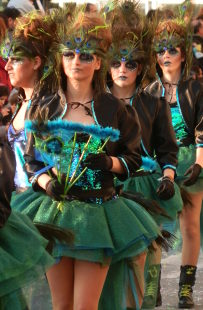 The processions in Palamos this year was reported at about 50 floats (I believe some others got up to closer to 80). The floats naturally follow the procession route but not as a steady moving stream.
The processions in Palamos this year was reported at about 50 floats (I believe some others got up to closer to 80). The floats naturally follow the procession route but not as a steady moving stream.
At one point (usually towards the end) there is a judges stand where each float and troupe takes the time to show and perform their choreography danced routine for 3-4 minutes. If you count 3-4 minutes per float and 50 floats plus time for walking and changeover it won't be surprising that a typical big carnival procession takes at least 4-5 hours to complete. The early floats starting in the daylight at the end of the afternoon, with the last ones coming in when its dark.
 Though the fun of taking part and showing off is a big part, a hidden incentive are the prizes for the best carrossers. There are normally different categories from best large float, best small float, best local float, best dance routine etc and for some of the main categories prize money can reach €1,000 for the winning float - though almost all of this prize money will be reinvested to build a bigger better float for the next year.
Though the fun of taking part and showing off is a big part, a hidden incentive are the prizes for the best carrossers. There are normally different categories from best large float, best small float, best local float, best dance routine etc and for some of the main categories prize money can reach €1,000 for the winning float - though almost all of this prize money will be reinvested to build a bigger better float for the next year.
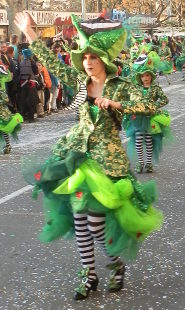 The run up to carnival (or carnestoltes) has children going to school in fancy dress (disfreses) with essentially a big party atmosphere all weekend - slightly amplified this year by Valentines Day, though Valentine's is somewhat new in Spain.
The run up to carnival (or carnestoltes) has children going to school in fancy dress (disfreses) with essentially a big party atmosphere all weekend - slightly amplified this year by Valentines Day, though Valentine's is somewhat new in Spain.
Palamos itself is an old royal port with an old central part and large fishing fleet. The main port is large enough for big ships and through the summer regularly gets visits from smaller cruise ships. Around the main port area and through the older part of the town there are many good restaurants and bars and streets that climb up and down across the headland in the heart of the old town.
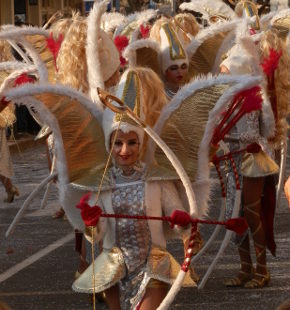 At the end of the headland is the new marina and around the corner is the extremely pretty soft-sand bay of La Fosca making the whole town one of many contrasts.
At the end of the headland is the new marina and around the corner is the extremely pretty soft-sand bay of La Fosca making the whole town one of many contrasts.
One downside for first time visitors is that Palamos has three enormous ugly tower blocks built just off the main beach and the blocky newer area behind the main beach passeo-walk both of which lack ambience and character which can leave a poor first impression. Our reaction on first visiting Palamos was that we didn't really care for the newer parts, but now we visit more often, we've found it growing on us as a town - it has a strong local character and joie de vivre that makes the place interesting year round.
Ceret (France)
 Ceret is a delightful French Catalan town, just the other side of the French border, just over an hour from the heart of the Costa Brava with a understated unspoilt charm and a strong connection to the Modern Art movement at the start of the 20th Century. Though it is marked from the autoroute, it's a town we have overlooked as we've headed more to Perpignan, to the mountains (eg Villefranche de Confluent) or to the coast - for instance to Elne on our previous French day-trips.
Ceret is a delightful French Catalan town, just the other side of the French border, just over an hour from the heart of the Costa Brava with a understated unspoilt charm and a strong connection to the Modern Art movement at the start of the 20th Century. Though it is marked from the autoroute, it's a town we have overlooked as we've headed more to Perpignan, to the mountains (eg Villefranche de Confluent) or to the coast - for instance to Elne on our previous French day-trips.
Ceret main claim to fame was though its connection to many famous twentieth century artists. Pablo Picasso (during his cubist phase) and George Braque were residents in 1911-1912 (eg see Picasso's Landscape at Ceret from the Guggenheim), attracting other famous artists like Chagall, Matisse and Modigliani. Ceret now has a Museum of Modern Art with works donated by these illustrious former residents.
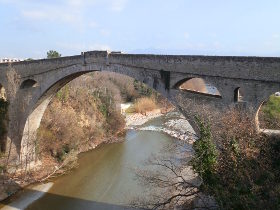 Now it's fair to say that we didn't know this before we visited - we were looking for somewhere new to go before doing our periodic foray into French supermarkets for cordial, cheese and a few other French delicacies that somehow never seem to cross the border, or are otherwise have massively over-inflated prices in Spain. As a result we haven't yet visited the museum, but from this one visit, Ceret now ranks as our favourite French Catalan town.
Now it's fair to say that we didn't know this before we visited - we were looking for somewhere new to go before doing our periodic foray into French supermarkets for cordial, cheese and a few other French delicacies that somehow never seem to cross the border, or are otherwise have massively over-inflated prices in Spain. As a result we haven't yet visited the museum, but from this one visit, Ceret now ranks as our favourite French Catalan town.
We parked just outside the town's outskirts on the far side of the river Tech and walked across the Devil's Bridge (Pont du Diable) - the old, very high, medieval stone bridge across the river that sits next to a modern road bridge. From here it was just a question of following our nose to reach the old town centre, a pleasant stroll through well-kept houses.
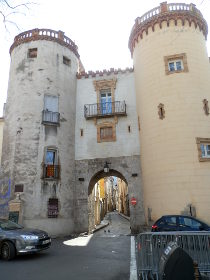 Though Ceret is definitely Catalan (road names are still in Catalan, often with a French alternative), it is a town that feels typically French - shutters on the windows, coloured walls on the outside of the buildings, people sat outside the cafes and tall plain trees for shade.
Though Ceret is definitely Catalan (road names are still in Catalan, often with a French alternative), it is a town that feels typically French - shutters on the windows, coloured walls on the outside of the buildings, people sat outside the cafes and tall plain trees for shade.
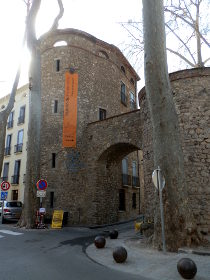 The first place of interest we came to was the large town gate flanked by two round towers (the Porte de France). This leads to old cobbled streets in the old centre, that curl around what would have been the town wall before coming together in the main town square or placa, with the Gran Cafe and hotel and a tower and arch construction which are what is left of the towns Porte d'Espange, at the back of which is a modern art fountain built to celebrate the towns connection with modern art with a copy of Picasso's Sardanes work. There are several little squares in the maze of streets and a number of different fountains through the town.
The first place of interest we came to was the large town gate flanked by two round towers (the Porte de France). This leads to old cobbled streets in the old centre, that curl around what would have been the town wall before coming together in the main town square or placa, with the Gran Cafe and hotel and a tower and arch construction which are what is left of the towns Porte d'Espange, at the back of which is a modern art fountain built to celebrate the towns connection with modern art with a copy of Picasso's Sardanes work. There are several little squares in the maze of streets and a number of different fountains through the town.
The town boasts two museums - the art museum mentioned and a museum of musical instruments, but this time around we didn't visit, but we may well come back in May for the town's cherry festival.
Also in France close to the Costa Brava
White water rafting in Quillan (France) - Collioure (France) - Villefranche-de-Conflent and Mont-Louis (France) - Perpignan - Elne (France) - Andorra La Vella - La Jonquera to Fort de Bellegarde (France) - Portbou to Cerbère (France) and back
Tamariu to Llafranc revisited
 We covered the walk from Far de Sant Sebastia (Llafranc) to Tamariu two Januaries ago but at the time part of the GR92 path was closed due to construction works and the weather was a little overcast. I added an update to the original to say the path is now open, but until now haven't updated the pictures, so this weekend we took advantage of the sun and recompleted the stretch from Tamariu to Llafranc, this time going all the way in and out of Cala Pedrosa to complete the coastal part of the walk.
We covered the walk from Far de Sant Sebastia (Llafranc) to Tamariu two Januaries ago but at the time part of the GR92 path was closed due to construction works and the weather was a little overcast. I added an update to the original to say the path is now open, but until now haven't updated the pictures, so this weekend we took advantage of the sun and recompleted the stretch from Tamariu to Llafranc, this time going all the way in and out of Cala Pedrosa to complete the coastal part of the walk.
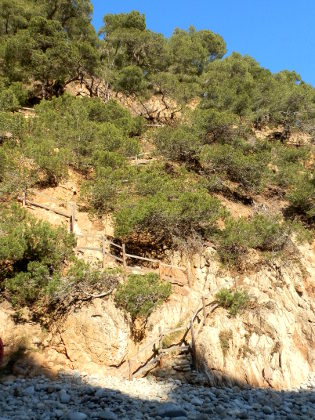 The bath is popular out of season, particularly on a gloriously sunny January Sunday and there were lots of families taking at least the first part of the route to the rocky bay and barraca just around from the main Tamariu beach (great for rock pools in the summer). It was good to run into German and English walkers too as the Costa Brava really is a fabulous winter destination for a little sun and good hiking.
The bath is popular out of season, particularly on a gloriously sunny January Sunday and there were lots of families taking at least the first part of the route to the rocky bay and barraca just around from the main Tamariu beach (great for rock pools in the summer). It was good to run into German and English walkers too as the Costa Brava really is a fabulous winter destination for a little sun and good hiking.
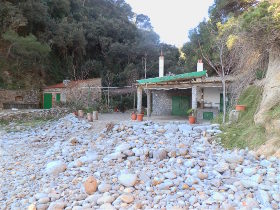 The main part of the walk which was closed last time runs at the back of two new villas and has been done up very well. The path now consists of a wooden gangway at the back of the houses above a small rocky cala, one of the classic Costa Brava inlet type coves with no access other than from the sea. The wooden gangway turns into a small walled path which a bit uneven where water has washed away the top of the path leaving some pipework exposed. This path then curves into the woods around La Musclera.
The main part of the walk which was closed last time runs at the back of two new villas and has been done up very well. The path now consists of a wooden gangway at the back of the houses above a small rocky cala, one of the classic Costa Brava inlet type coves with no access other than from the sea. The wooden gangway turns into a small walled path which a bit uneven where water has washed away the top of the path leaving some pipework exposed. This path then curves into the woods around La Musclera.
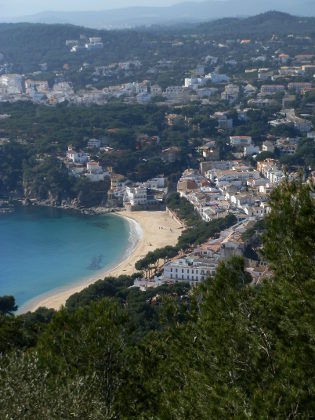 The route then climbs around the Musclera headland, getting quite high above a cliffside before connecting to the path down to Cala Pedrosa. This particular path goes steeply down the hillside along a narrow cliff-side path with wooden barriers/bannisters all the way down to the Cala. It's not difficult, but it is steep as it zig-zags up the side of the bay. At the bottom, we reach a large bay filled with large pebblestones. Pedrosa means stony or rocky and the pebbles are chunky inviting you to make pebble stacks or to try skimming the stones out across the water. At the back of the bay is a small house/bar that it often open in summer sometimes serving food straight off the barbeque.
The route then climbs around the Musclera headland, getting quite high above a cliffside before connecting to the path down to Cala Pedrosa. This particular path goes steeply down the hillside along a narrow cliff-side path with wooden barriers/bannisters all the way down to the Cala. It's not difficult, but it is steep as it zig-zags up the side of the bay. At the bottom, we reach a large bay filled with large pebblestones. Pedrosa means stony or rocky and the pebbles are chunky inviting you to make pebble stacks or to try skimming the stones out across the water. At the back of the bay is a small house/bar that it often open in summer sometimes serving food straight off the barbeque.
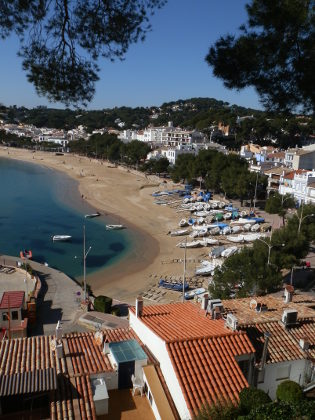 The path out of Cala Pedrosa runs along the stream at the back of the bay, through a shaded valley that was cool in the January air unlike the sunnier parts of the walk. At the top it meets a broader track/path at the back of a view houses before running past first fields and then woods up to the lighthouse (Far de San Sebastien) above Llafranc. The lighthouse can be approached from two directions. The main GR92 path runs high above the sea and gets a little high if you're not comfortable with heights, before connecting to the watchtower next to the Restaurant de Far at the top behind the lighthouse. This time we turned right earlier, following a forestry track that connects to houses on the other side of the hill (Carrer Panama), then taking the road across the top of Llafranc. The views from the lighthouse are spectacular. As this was a particularly clear day, we could see the snow on the Pyrenees behind Palafrugell on one side and the coastline and beaches stretching away to the south past Palamos on the other.
The path out of Cala Pedrosa runs along the stream at the back of the bay, through a shaded valley that was cool in the January air unlike the sunnier parts of the walk. At the top it meets a broader track/path at the back of a view houses before running past first fields and then woods up to the lighthouse (Far de San Sebastien) above Llafranc. The lighthouse can be approached from two directions. The main GR92 path runs high above the sea and gets a little high if you're not comfortable with heights, before connecting to the watchtower next to the Restaurant de Far at the top behind the lighthouse. This time we turned right earlier, following a forestry track that connects to houses on the other side of the hill (Carrer Panama), then taking the road across the top of Llafranc. The views from the lighthouse are spectacular. As this was a particularly clear day, we could see the snow on the Pyrenees behind Palafrugell on one side and the coastline and beaches stretching away to the south past Palamos on the other.
For a walking route see the original: Far de Sant Sebastia (Llafranc) to Tamariu
Ribes de Freser and skiing at Vall de Nuria
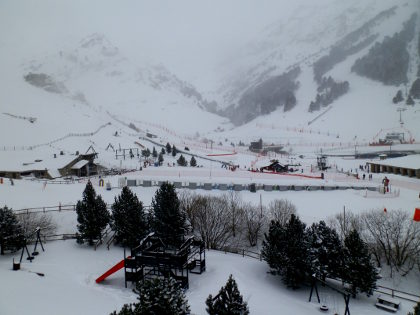 The nearest ski stations to the Costa Brava in the Pyrenees are Vallter 2000 (above Setcases) and Vall de Nuria, with larger ski resorts a little further away in La Molina and Massala near Puigcerda (on a train line from Barcelona) and further options up to Andorra.
The nearest ski stations to the Costa Brava in the Pyrenees are Vallter 2000 (above Setcases) and Vall de Nuria, with larger ski resorts a little further away in La Molina and Massala near Puigcerda (on a train line from Barcelona) and further options up to Andorra.
With snow arriving in the mountains we travelled up to Ribes de Freser to catch the Cremellera rank-and-pinion train up to the snow at Vall de Nuria - the only transportation link into the resort. Using the train means we don't have the risk of needing to drive in snow but can park at Ribes de Freser and let the train do the work through a spectacular climb up to Vall de Nuria. Our journey time to Ribes de Freser was about two hours with another 30 minutes for the train ride.
 Vall de Nuria is not large - there are approximately 6-7km of pistes, around one third of which are blue runs but for beginners or those just wanting a taste of the snow it provides a startling contrast to a a day on the beach.
Vall de Nuria is not large - there are approximately 6-7km of pistes, around one third of which are blue runs but for beginners or those just wanting a taste of the snow it provides a startling contrast to a a day on the beach.
The train leaves from Ribes de Freser, a small Catalan mountain town on the road to Puigcerda. The stone of the buildings is more muted than the golden hues closer to the close giving the town a sense of rough hewn grit. Ribes actually has two stations for the Cremallera train - one on the outskirts that connects with trains from Barcelona, and a more central Estacio de la Vila in the heart of the town. We parked close to the tourist office which is near the first of the stations and then walked to the central station stretching our legs from the journey and revelling in the sugaring of snow.
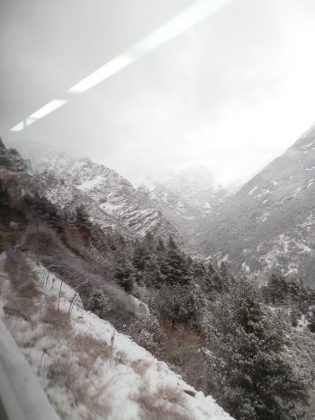 However, this little walk meant we missed the first train we could have caught so we had to wait for 40 minutes or so in the station as trains leave about every hour. If you want to minimise your travel time, keeping an eye on the train times will help with journey.
However, this little walk meant we missed the first train we could have caught so we had to wait for 40 minutes or so in the station as trains leave about every hour. If you want to minimise your travel time, keeping an eye on the train times will help with journey.
The delay did mean we could properly find out what the options were for going up. From the station you can buy the Cremallera ticket which gives you the train ride and access to the main buildings at the top, or for a little bit more buy a Forfait or Skipass for all the lifts if you want to go skiing or snowboarding. Ski and Snowboard hire is done separately when you get to the top. An alternative for small children might be to get the ticket that includes the Parc Ludic - a snow park with slides and rubber ring sledges for younger children.
We were travelling with a dog and weren't sure what the reaction was. We had read it was possible to take dogs and when we got there it was pretty obvious this is quite normal. The formal rules say dogs should be muzzled. Our dog is very passive and though we took a muzzle with us, we didn't have to use it. Bigger or more noisy or aggressive dogs might be different.
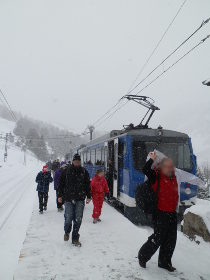 The journey up takes about 30 minutes of steady climb - it's not express type of speeds, but there is a good amount of climb and spectacular scenery on the way with a small viaduct, cliffs, cuts through the rocks, gorges and dramatic mountain scenery. For us the train journey was worth the trip.
The journey up takes about 30 minutes of steady climb - it's not express type of speeds, but there is a good amount of climb and spectacular scenery on the way with a small viaduct, cliffs, cuts through the rocks, gorges and dramatic mountain scenery. For us the train journey was worth the trip.
We arrived at the train station at the top which is right next to the large almost barracks type building that acts as the centre for all the activities. The day we were visiting it was cold - around -7C and snowing, but with a gusting wind that created white-out snow flurries from time to time. So not the best day for photographs, but lots of fresh powder snow for skiing.
The first thing was to get kitted out. There is a big and very efficient rental hall which means hiring skis, boards, boots and helmets was fast and painless. The only slight look-out is that you will need a passport or identity card for identification when making the hire. I'd left mine in the car at the bottom, so it was a good thing my better half had hers.
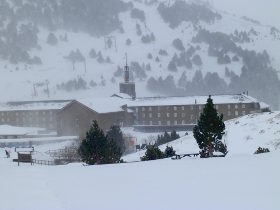 For ski-ing there is a telecabin lift and a chair lift to the higher parts, and around the lower parts a small button lift. For beginners, the skiing starts from an almost flat green slope. For other skiers there are a number of blue runs, 2-3 red runs and one black run. Not really so much for more experienced skiers but possibly enough for the occasional one-a-year day out.
For ski-ing there is a telecabin lift and a chair lift to the higher parts, and around the lower parts a small button lift. For beginners, the skiing starts from an almost flat green slope. For other skiers there are a number of blue runs, 2-3 red runs and one black run. Not really so much for more experienced skiers but possibly enough for the occasional one-a-year day out.
So while our children went off for skiing we explored the lower area. The main building actually works very well if you're not skiing. There is a small cafe, a shop, a large restaurant and, very welcome for us given we had a dog with us, a large room for 'picnics' - basically somewhere warm to hang out without feeling that you have to buy something. The rest of the building is partly hotel, partly church and sanctuary (Vall de Nuria has a history as a place of religious devotion), and partly museum. While not particularly exciting, the museum is interesting and helps set the scene for the history and ecology of the valley.
Around the main building children were messing about on sledges. Unlike Switzerland or bigger ski resorts where there are often long specialist sledging tracks for free for those who don't want to ski, the areas for sledging were relatively small and really just for smaller children.
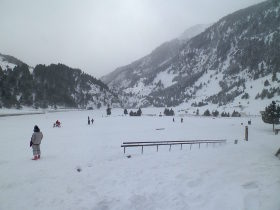 The day of visiting, the snow was deep making walking difficult and it was bitterly cold and we didn't really want to get too far from the shelter of the main building. For summer walking there are routes down the valley all the way back to Ribes de Freser (marked as being 5h50) - the traditional pilgrims route.
The day of visiting, the snow was deep making walking difficult and it was bitterly cold and we didn't really want to get too far from the shelter of the main building. For summer walking there are routes down the valley all the way back to Ribes de Freser (marked as being 5h50) - the traditional pilgrims route.
The end of the day for us came a little earlier than planned, partly because of the cold. Obviously for day trips you can try to pick and choose the day for visiting to both have snow and good weather. The train was efficient and ran on time and we worked out that from the time the train left at the top to getting home was about two and an half hours. Not bad for a little bit of winter wonderland.
White water rafting in Quillan (France) - Andorra La Vella - Mollo (Camprodon) - Pyrenees to France - Visit to Setcases - Villefranche-de-Conflent and Mont-Louis (France) - Olot - capital of Garrotxa - Puigcerda and Bourg-Madame
Sant Grau and Cadiretes near Tossa de Mar
 Tossa de Mar is one of the most famous towns on the Costa Brava because of its walled village next to the sea and beautiful bays. However, it has a relatively isolated location as it and Sant Feliu de Guixols are separated by a very windy road along the coast and the hills of the Massis de les Cadiretes. For walkers, the GR92 coastal path between the towns goes inland over the hills, while the coastal route up and down a number of cliffy calas is all road with no natural walking route. However, the road is extremely popular with cyclists (amateurs and professionals) as it's extremely scenic and too slow and bendy to be a main route for cars.
Tossa de Mar is one of the most famous towns on the Costa Brava because of its walled village next to the sea and beautiful bays. However, it has a relatively isolated location as it and Sant Feliu de Guixols are separated by a very windy road along the coast and the hills of the Massis de les Cadiretes. For walkers, the GR92 coastal path between the towns goes inland over the hills, while the coastal route up and down a number of cliffy calas is all road with no natural walking route. However, the road is extremely popular with cyclists (amateurs and professionals) as it's extremely scenic and too slow and bendy to be a main route for cars.
The Cadiretes hills therefore form a relatively isolated and empty wilderness between Tossa and Sant Feliu with remains of chapels and fortifications and a few scattered houses but not much else. This is a walk on the GR92 from just about Sant Grau - marked as the castle at Montagut (though we somehow missed the castle). The first part of the walk has views inland towards Llagostera and Girona, and comes back to Sant Grau on the sea-view side. It's a fairly typical wooded walk with some interesting rock formations and some views because of the height, but would otherwise be relatively unremarkable except for the rave party we walked past.
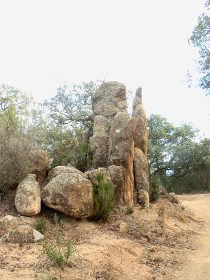 We arrive by car from Llagostera on the road to Sant Grau winding into the hills with a valley to our right. The area marked as the castle for Montagut has a track with a wide-ish entrance and space to park, so we stopped at the track. We were however surprised at the number of cars around. Initially we thought it was for hunting, as we'd just passed a collection of hunters with what looked like four or five boar further down the hillside.
We arrive by car from Llagostera on the road to Sant Grau winding into the hills with a valley to our right. The area marked as the castle for Montagut has a track with a wide-ish entrance and space to park, so we stopped at the track. We were however surprised at the number of cars around. Initially we thought it was for hunting, as we'd just passed a collection of hunters with what looked like four or five boar further down the hillside.
We start to walk along the broad gravel track and pass yet more cars and it becomes clear from the number of young people milling around and the slightly odd looks that we get that there we're passing some form of music gathering in one of the abandoned farmhouses. No doubt this was a one off, but it feels a little strange and incongruous for a Sunday afternoon stroll in the middle of nowhere and as we pass the last of the cars the music starts we find ourselves walking to the accompanyment of a bass-and-drum beat.
The track runs along the side of the hill with small mounds of rocks 10-20m high in places and from the top of the rocks, the view is spectacular out across towards Girona and Lagostera. The path is a fairly standard wooded path though without much in the way of other highlights.
As we get towards our turning point (where the GR92 meets a local yellow-white sender), we can see the remains of a chapel just around the next bend in the hill looking back at us. However, we reach the junction first and so don't explore further, instead turning back towards the right across a small col and walking on the other side of the hill. From this side we now have views to the sea and across to some of the more isolated housing estates that dot the route between Tossa and Sant Feliu.
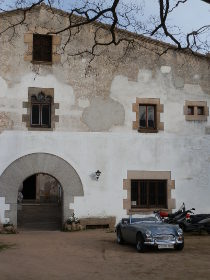 The walk is then a steady path that curls beside more strange rock formations before we get the sight of the church of Sant Grau above us. We curl around the hillside and across a small stream before what is a relatively sharp incline upto the village of Sant Grau.
The walk is then a steady path that curls beside more strange rock formations before we get the sight of the church of Sant Grau above us. We curl around the hillside and across a small stream before what is a relatively sharp incline upto the village of Sant Grau.
The village itself consists of the church with attached house, presumably as part of a monestary at one point and a scattering of old masias and a few isolated villas in the woods with views out towards the sea, quite a long way down below. The area looks like it was once ear-marked as a tourist development as there is an abandoned swimming pool overlooking the valley and a few unconnected roads abandoned before construction started.
We take the road back. The map marks a couple of points just off the road, but we just head back. The road is quiet with no traffic. Towards the top we reach the connection to the GR92 once more and follow the path towards the telecom masts at the top of the hill expecting to find the castle of Montagut, but we miss it again.
Back at the car we then take the hairpinned road down to the coast to get back via Sant Feliu de Guixols half giddy from the curves. In general, the walk was OK without being spectacular and lacked a little in terms of points of interest for the driving involved.
See also: Tossa de Mar north to Cala Pola - Sant Feliu de Guixols Pedralta - Solius, rocks for climbing and ruined castle - Llagostera to Sant Llorenç - Swimming and beaches of Tossa de Mar
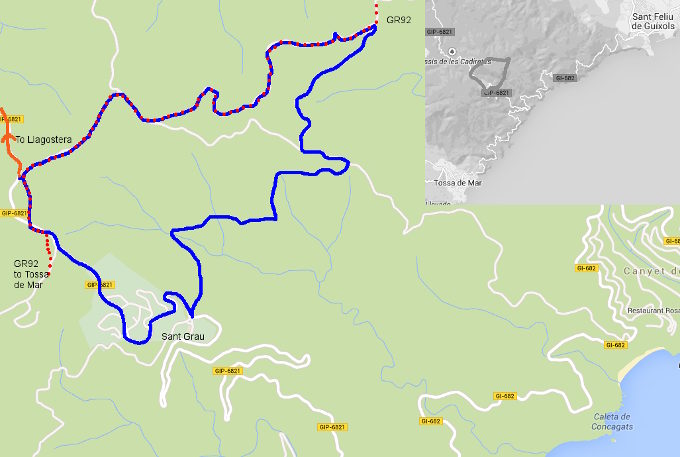
Fontclara and Fontanilles and Pals rice paddies
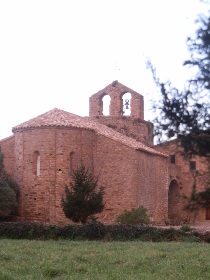 The area between Pals and Torroella de Montgri is a flat area full of fields for growing rice as it was once the site of an ancient lake or sea marsh fed by the waters of the river Ter. The neighbouring villages of Fontclara and Fontanilles fringe these paddy-fields until they turn into fruit-growing areas close to Fontanilles. As you pass through this area over the course of a year, you'll see the paddy fields flooded, planted, rice growing and then being harvested.
The area between Pals and Torroella de Montgri is a flat area full of fields for growing rice as it was once the site of an ancient lake or sea marsh fed by the waters of the river Ter. The neighbouring villages of Fontclara and Fontanilles fringe these paddy-fields until they turn into fruit-growing areas close to Fontanilles. As you pass through this area over the course of a year, you'll see the paddy fields flooded, planted, rice growing and then being harvested.
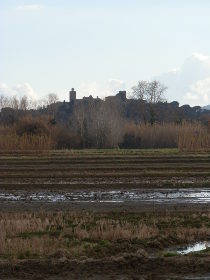 Flatness generally for me, doesn't make a good walk as it lacks variation, but this is an area we hadn't explored and there is an old rice mill (Moli d'Arros in the middle of the paddy fields). What was more of a surprise was the number of birds we saw. Being January with water still in the fields, they are like a wetlands for birds and we were lucky enough to see a stork, lots of herons, plovers and a number of birds of prey. The downside that we discovered was that the route from the mill to Fontanilles was exclusively on the road. We may have missed a turn, but other tracks into the fruit espaliers were marked as private.
Flatness generally for me, doesn't make a good walk as it lacks variation, but this is an area we hadn't explored and there is an old rice mill (Moli d'Arros in the middle of the paddy fields). What was more of a surprise was the number of birds we saw. Being January with water still in the fields, they are like a wetlands for birds and we were lucky enough to see a stork, lots of herons, plovers and a number of birds of prey. The downside that we discovered was that the route from the mill to Fontanilles was exclusively on the road. We may have missed a turn, but other tracks into the fruit espaliers were marked as private.
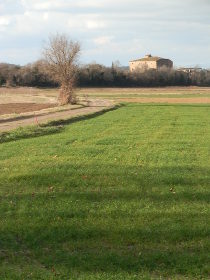 We start in Fontclara, a small but well-to-do hamlet close to Palau-sator and from here we take the path across the fields in the direction of Pals - actually part of the GR92. The path is raised from the level of the fields and each field is bounded by a low mud bankl. When the time comes, farmers flood the fields using the many pumps that can be seen around the field edges. At this time of year (January), the ground is muddy and natural rain water sits in the bottom of the fields. The presence of water and, we suspect, frogs and snails in the water means we can see a heron in just about every field that we pass. On the drive in we were even lucky enough to see a stork. And between the heron fields there are plovers and smaller birds sometimes being monitored by a larger bird of prey.
We start in Fontclara, a small but well-to-do hamlet close to Palau-sator and from here we take the path across the fields in the direction of Pals - actually part of the GR92. The path is raised from the level of the fields and each field is bounded by a low mud bankl. When the time comes, farmers flood the fields using the many pumps that can be seen around the field edges. At this time of year (January), the ground is muddy and natural rain water sits in the bottom of the fields. The presence of water and, we suspect, frogs and snails in the water means we can see a heron in just about every field that we pass. On the drive in we were even lucky enough to see a stork. And between the heron fields there are plovers and smaller birds sometimes being monitored by a larger bird of prey.
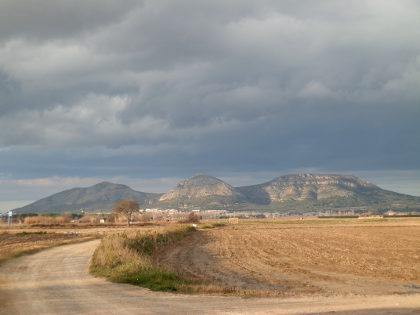 The walk is naturally flat, though being lower than the surrounding countryside we have views up to Pals, standing almost as an island over the fields, and to Quermany and Begur with a sweeping vista towards the hills and then more distant Pyrenees mountains in the background.
The walk is naturally flat, though being lower than the surrounding countryside we have views up to Pals, standing almost as an island over the fields, and to Quermany and Begur with a sweeping vista towards the hills and then more distant Pyrenees mountains in the background.
The first place of interest is Can Bach, just across the road that connects to Peratallada. This is an enormous square masia, part of which has been converted into a restaurant. The main part of the building still needs renavation work, but the restaurant is open and busy by the number of cars. One concern that visitors have coming to the Costa Brava out of season, is that places will be closed up. While this is true closer to the coast, inland there is a great vitality all year round with many places open and catering to local and more widespread Catalan visitors.
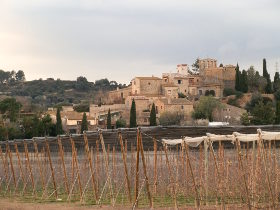 Many of the year round restaurants are therefore off the coast - often in older masia buildings a little way from a village. There a large number in the area of Pals, Palau-sator and Peratallada area with a particular focus on Catalan cooking.
Many of the year round restaurants are therefore off the coast - often in older masia buildings a little way from a village. There a large number in the area of Pals, Palau-sator and Peratallada area with a particular focus on Catalan cooking.
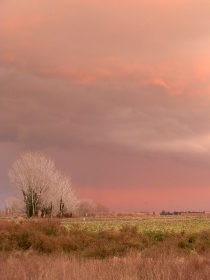 From Can Bach we continue towards Pals up to a signpost where we turn left (marked towards Les Basses d'en Coll - a small wetlands area by the beach). To our right we have Pals standing above us like a castle and the villas of Masos de Pals gleaming in the afternoon sun. The path runs just along the main road, and then crosses to get to the Moli d'Arros. The Moli is closed, but is where Arros de Pals is collected and packaged from the rice fields around. As a rice growing area, Pals is relatively small and select, particularly compared to the Delta d'Ebre, the other source of Catalan rice - but is available in local shops and supermarkets.
From Can Bach we continue towards Pals up to a signpost where we turn left (marked towards Les Basses d'en Coll - a small wetlands area by the beach). To our right we have Pals standing above us like a castle and the villas of Masos de Pals gleaming in the afternoon sun. The path runs just along the main road, and then crosses to get to the Moli d'Arros. The Moli is closed, but is where Arros de Pals is collected and packaged from the rice fields around. As a rice growing area, Pals is relatively small and select, particularly compared to the Delta d'Ebre, the other source of Catalan rice - but is available in local shops and supermarkets.
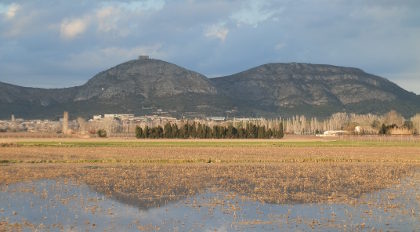 From the Moli, we continue on the east side of the Torroella road looking out to the small airfield, before crossing the road again and heading towards Fontanilles. Our route back to Fontclara is all road passing next to the espalier orchards that bear the other produce of this area - apples and fruit. The road is relatively newly built and quiet wide, but actually very quite in terms of traffic. As we're walking we can watch a storm crossing over Montgri bringing rain and lightning to L'Estartit in the distance and thunder echoing over the plain. We're still in the last sun of the day which lights the fruit-trees against the dark black of the distant storm.
From the Moli, we continue on the east side of the Torroella road looking out to the small airfield, before crossing the road again and heading towards Fontanilles. Our route back to Fontclara is all road passing next to the espalier orchards that bear the other produce of this area - apples and fruit. The road is relatively newly built and quiet wide, but actually very quite in terms of traffic. As we're walking we can watch a storm crossing over Montgri bringing rain and lightning to L'Estartit in the distance and thunder echoing over the plain. We're still in the last sun of the day which lights the fruit-trees against the dark black of the distant storm.
See also: Masos de Pals, Begur, Sa Riera and Platja de Pals - Palau-sator and Peratallada - Regencos to Pals via Quermany Gros and Petit - Evening walk Pals to Sant Feliu de Boada - Pals beach to Gola de Ter - Gualta, Llabia, Fontanilles and the lake of Ullastret
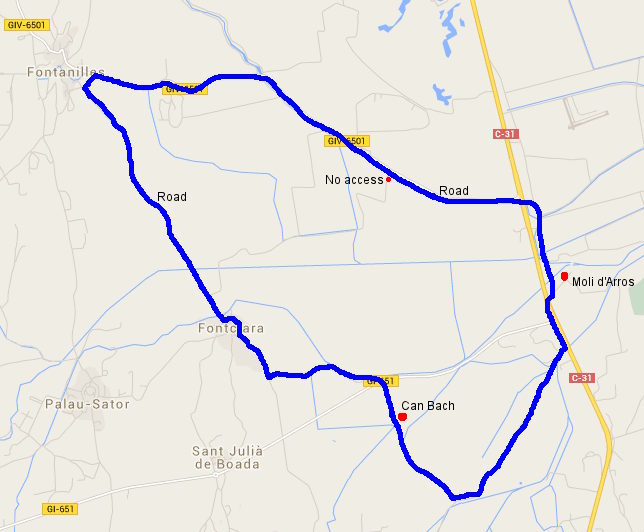
Cruilles and masias and streams
 Cruilles is an ancient village just to the west of La Bisbal d'Emporda both of which are important in Emporda's medieval history as locations of lords and bishops, and as such there is a timeless beauty to what the rural countryside in this area stretching across ancient meadows and into the slopes of the Gavarres Hills.
Cruilles is an ancient village just to the west of La Bisbal d'Emporda both of which are important in Emporda's medieval history as locations of lords and bishops, and as such there is a timeless beauty to what the rural countryside in this area stretching across ancient meadows and into the slopes of the Gavarres Hills.
The route we're taking consists of two yellow-white senderisme paths which follow river valleys and which are connected with a route over the top of the hill that separates them. The route is broad and well maintained with markings are clear and easy to follow with signposting at crucial junctions, so it's actually easier to walk than describe. It is marked in yellow on the Emporda Costa Brava maps, but difficult to work out from Google maps.
 We're walking in January which is currently very warm - 14-15C, but there is still water in the streams and the paths are lightly muddy rather than the dry summer sand and dust. We had to cross a lot of streams and fords which was fun, but many of the streams would probably be dried out in summer.
We're walking in January which is currently very warm - 14-15C, but there is still water in the streams and the paths are lightly muddy rather than the dry summer sand and dust. We had to cross a lot of streams and fords which was fun, but many of the streams would probably be dried out in summer.
We park just outside the centre of Cruilles just off the road to La Bisbal d'Emporda. We've included a visit to Cruilles in a previous walk for a fuller description of the town and its famous tower, but this time we were more interested in heading out into the countryside.
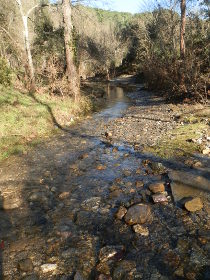 The initial part of the walk is on a quiet road and splits just in front of a masia farmhouse. We take the right fork and continue along the road and through the fields and meadows towards the next old farmhouses. These masias are large buildings with thick walls and small windows sitting under long sloping roof. Close to the sea the buildings have towers added on that would have been used to watch for pirates, but here tucked away towards the hills they are just large practical buildings built three or more centuries ago to work the surrounding land. Many have now been updated and renovated into luxury houses with large gardens and pools, but it is also still possible to find masias in a more original state.
The initial part of the walk is on a quiet road and splits just in front of a masia farmhouse. We take the right fork and continue along the road and through the fields and meadows towards the next old farmhouses. These masias are large buildings with thick walls and small windows sitting under long sloping roof. Close to the sea the buildings have towers added on that would have been used to watch for pirates, but here tucked away towards the hills they are just large practical buildings built three or more centuries ago to work the surrounding land. Many have now been updated and renovated into luxury houses with large gardens and pools, but it is also still possible to find masias in a more original state.
The path we're taking is marked yellow-white and is clearly marked. At prominent junctions there are also signposts, so it's easy to follow the route as it crosses a couple of more junctions. Behind us we can see Cruilles and it's tower and church, and next door the older more isolated church of Sant Miquel de Cruilles. At this stage we're still in fields, but we can see woods ahead of us as we move towards the slopes of the Gavarres and see the domed tower of Puig d'Arques almost straight ahead.
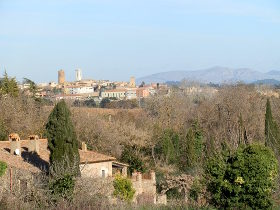 The path runs past another masia and converts into a gravel track then a little further on branches to the right and climbs a thinner walking path until we are above the top of an old mill and millstream giving views into the Gavarres valleys and back to Cruilles. Coming down the track we pass the outer wall of the mill - almost like a ha-ha (a wall with a ditch on one side) and what looks like a traditional charcoaling oven.
The path runs past another masia and converts into a gravel track then a little further on branches to the right and climbs a thinner walking path until we are above the top of an old mill and millstream giving views into the Gavarres valleys and back to Cruilles. Coming down the track we pass the outer wall of the mill - almost like a ha-ha (a wall with a ditch on one side) and what looks like a traditional charcoaling oven.
At the end of the wall we find the stream that feeds the mill - a glistening early stream that forms the River Daro as it passes past La Bisbal downstream. We don't have to cross this time and can just admire the location - but there is water in the stream in January and to get across we have to tiptoe over the rocks in the stream.
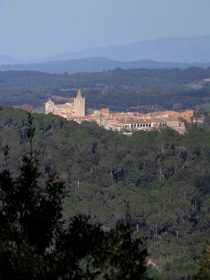 This is now just the first time we'll see water. As we go on, the path runs into the woods continually cutting across the stream line. Mostly the track goes through the water of the brook, and in drier periods it is most probable that there would be no water to worry about. We have the fun of creating stepping stones with great splashes that delight our dog.
This is now just the first time we'll see water. As we go on, the path runs into the woods continually cutting across the stream line. Mostly the track goes through the water of the brook, and in drier periods it is most probable that there would be no water to worry about. We have the fun of creating stepping stones with great splashes that delight our dog.
One of the oddities of a warm January afternoon in the woods is that in the sun we have proper warmth, but in the shadow and shadier parts there is a frisson of chill. Close to the stream at one point we even found frost on the ground and a mystical mist rising from the water into the still cold air.
After about 3-4 crossings, the path turns upwards and into the hills giving views of a more isolated masia hidden in the woods. The path runs up to the top of the hill and about half way up we pass what seems to a very large and very old oak.
The top of the hill gives further views and we can see to Sant Sadurni, the neighbouring village to Cruilles and more hidden masias in the valley.
Across the top of the hill, we look out for the crossing points as we want to change paths. The first crossing point is just by the fence to another grand masia and on a good drivable track. This road then takes us down the hill a little to the next crossing to the left, where the sign has fallen down, but would point back towards La Bisbal.
The return through the woods is a pleasant stroll along the bottom of the valley but lacks the fun of crossing the stream that we had in the other valley. Eventually the path emerges back into the fields and now pig farms before tracking to a large walkers bridge over the Daro. The bridge looks much too big for the amount of water, but we know that in heavy rains, many of the rivers quickly become swollen which is probably why the bridge needs to be so high and long.
We divert along the side of the river through the woods instead of going straight back to Cruilles - we can see a river crossing on the map. However, when we get there, there's another minor problem - the river is up and the crossing we can see is a ford. Luckily we find another few bricks in the shallower water and can cross without getting feet wet and have an easy walk back to the car.
See also: Cruilles, Monells and Sant Sadurni de l'Heura - Monells and Mont-negre - Corça, Casavells, Matajudaica - La Bisbal, Vulpellac, Castell d'Emporda, Fonteta - St Pol de Bisbal and Santa Lucia - Madremanya, Els Angels, Sant Marti Vell

Centre Cani de Pals dog kennels
This Christmas we headed off to snowier climes to meet up with relatives, but this meant that we needed to leave Zina our dog here as we were flying. She's not a special pedigree or anything sophisticated - in fact we got her from the Rodamon dogs rescue centre just outside Palafrugell when we moved here (they're always looking for dog walkers). However, perhaps because she was in dogs home, she's quite timid around other dogs and our one other experience of leaving her at a dog kennel (Elena's near Regencos) in summer wasn't very positive. So it was with some trepidation that we booked her into the Centre Cani de Pals over the winter break.
However, this time the experience was much much happier. The Centre Cani de Pals is both a kennels and dog training centre with a strong sense of care and affection for the animals. The dogs were segregated into smaller areas with a handful of dogs of similar size in each pound so smaller sized dogs weren't dominated by too many bigger dogs and there were internal spaces and housing so the dogs could find their own spaces. We were allowed to leave Zina at the centre to acclimatise for an hour or so a few days prior to the trip, which settled our nerves and meant it wasn't so strange for Zina. It also meant we could see how well the staff treated the dogs and their care and attention. And while dogs are never keen on going to kennels, when we got back at the end of the trip Zina was being sociable with the other dogs in her area and looked very fit and healthy with no signs of problems or trauma. Definitely a dogs kennels to be recommended.
Llança
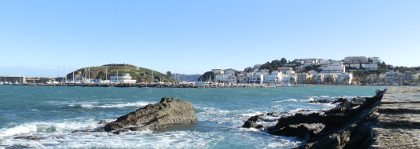 Llança is in the northern part of the Costa Brava between Cap de Creus and France. It is on the train line from Figueres to Cerbere and so easily accessible by public transport. Until recently this was the only trainline out from Spain to France on the Mediterranean side but from Llança north it is a slow and steady journey along the coast. There is also a road that follows the coast, weaving and bending with the rugged coastline by hills of low scrub and olive groves - again not a journey if you want to travel quickly.
Llança is in the northern part of the Costa Brava between Cap de Creus and France. It is on the train line from Figueres to Cerbere and so easily accessible by public transport. Until recently this was the only trainline out from Spain to France on the Mediterranean side but from Llança north it is a slow and steady journey along the coast. There is also a road that follows the coast, weaving and bending with the rugged coastline by hills of low scrub and olive groves - again not a journey if you want to travel quickly.
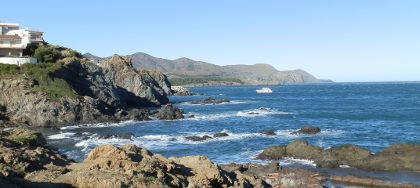 Llança, like it's neighbour Port de La Selva, has the feeling of a harsher landscape than the gentler fields and welcoming calas further south - there is an air of untamed wildness in the scrub-covered hills and the rough rocks that jut at angles leaving sharp edges. The sand is dark grey, soft in places, but pebbly in others. This wildness which was increased for us by the strong wind and white horses on the sea and the fill of driftwood from the recent storms that scattered across the beaches.
Llança, like it's neighbour Port de La Selva, has the feeling of a harsher landscape than the gentler fields and welcoming calas further south - there is an air of untamed wildness in the scrub-covered hills and the rough rocks that jut at angles leaving sharp edges. The sand is dark grey, soft in places, but pebbly in others. This wildness which was increased for us by the strong wind and white horses on the sea and the fill of driftwood from the recent storms that scattered across the beaches.
 We're a little behind on our walks over the last month. The early part of November was unseasonably hot, with people sunbathing and swimming in the sea in the first week of November. And then rain and fog came (including floods in Figueres) which, combined with being a taxi service for some very active children, meant that we've been walking closer to home and revisiting walks we've already added.
We're a little behind on our walks over the last month. The early part of November was unseasonably hot, with people sunbathing and swimming in the sea in the first week of November. And then rain and fog came (including floods in Figueres) which, combined with being a taxi service for some very active children, meant that we've been walking closer to home and revisiting walks we've already added.
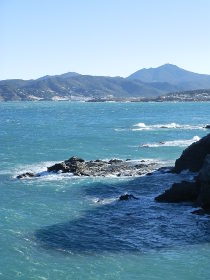 This weekend though, blue sky is back and the autumn temperatures have returned to something normal for the time of year (more 14-17C) and for the first time this autumn we have our mountains back - the crystal clear views to the Pyrenees that we get once the dusty haze of the summer blows away. There's snow too. Canigou's white top can be seen from the Palafrugell to La Bisbal road again.
This weekend though, blue sky is back and the autumn temperatures have returned to something normal for the time of year (more 14-17C) and for the first time this autumn we have our mountains back - the crystal clear views to the Pyrenees that we get once the dusty haze of the summer blows away. There's snow too. Canigou's white top can be seen from the Palafrugell to La Bisbal road again.
So we're up to visit Llança. The town is slightly separate from the port, so we park near the Port in a strong Traumuntana wind which is whipping up the sea. From the car park we walk to the sea itself for some bracing sea air, then follow the promenade past the modern houses which faces the nest of buildings of Port de Llança and the small marina in front of us. Behind us, the hills climb to the back of the housing estate and along the coast we get views of the windswept headlands towards France. And out at sea there are some hardy souls on jetskis using the rough conditions for jumping.
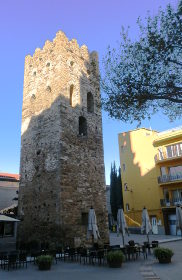 A bridge crosses a small river into the bay of the port, which has a crescent shaped sandy beach in the dark sand typical of this area. Ahead of us is a small hill (the Castellar) with a number of people out for a breezy sunday afternoon stroll. We walk up the hill and get views up the coast to Port de la Selva. The village of the Port is separate from the main town of Llança and consists of a small nucleas of houses, bars, restaurants and shops that climb up on the headland.
A bridge crosses a small river into the bay of the port, which has a crescent shaped sandy beach in the dark sand typical of this area. Ahead of us is a small hill (the Castellar) with a number of people out for a breezy sunday afternoon stroll. We walk up the hill and get views up the coast to Port de la Selva. The village of the Port is separate from the main town of Llança and consists of a small nucleas of houses, bars, restaurants and shops that climb up on the headland.
There is a marked coastal path (green-red), however from the port side closest to the sea, the route has been blocked, so we have to navigate through the streets up the hill of the headland. At the top we find the path continues above the cliffs with pre-prepared steps, but the wind is sufficiently strong that we actually stick to the estate roads among the houses and villas until we reach a lower point (it's not particularly high, but the wind was quite fierce).
After curling through the streets we navigate back towards the sea and reconnect with the coastal path, following it around the rocky headlands. The stones and rocks in this area are quite dark and jagged with sharp corners so we stick to the path. It follows around a number of small bays with beaches of grey sand in places, pebbles in others.
The storms have brought driftwood in to the bays and they are littered with trees and branches washed clean by the sea, lying among seaweed that lends a nautical smell like an English beach. The path is undergoing some recontruction, but we walk round with no problem coming to Platja les Tonyines before turning back to the town above Cala de la Loup.
We walk the straightest route to town along a relatively plain street, heading directly for the church. The inner part of Llança has a core of small streets, in amongst shops and a commercial district. The church is quite grand and stands next to an old Romanic tower in a placa in the centre of the town.
We're suffering from wind noise and so don't explore too much, but instead head back to the port.
Neighbouring walks: Port de la Selva - Espolla to Rabos - Cadaques and Port Lligat - Sant Pere de Rodes - Figueres and Castell de Sant Ferran - Cadaques to Roses - Peralada - La Jonquera to Fort de Bellegarde (France) - Collioure (France) - Portbou to Cerbère (France) and back

Andorra La Vella
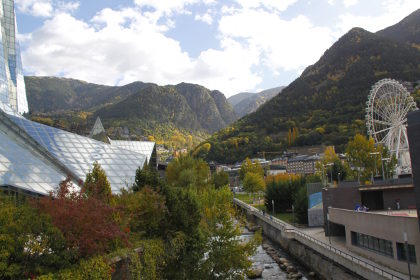 Andorra is one of Europe's smallest countries, located in the high Pyrenees between Spain and France and known for cheap skiing and duty free shopping. From Barcelona, Andorra can be reached in about 2-3 hours, but it's a little further from the Costa Brava as the most direct route along the foothills of the Pyrenees is relatively slow and windy.
Andorra is one of Europe's smallest countries, located in the high Pyrenees between Spain and France and known for cheap skiing and duty free shopping. From Barcelona, Andorra can be reached in about 2-3 hours, but it's a little further from the Costa Brava as the most direct route along the foothills of the Pyrenees is relatively slow and windy.
Andorra has a certain novelty value because of its size and there is a steady stream of traffic that passes through just to see what it is like - from both France and from Spain. We've driven through about three or four times, but not really stopped - so it can seem like just one road with few shopping centres at one end and a few ski resorts at the other. However, the last weekend my son had a handball match against an Andorran team with a bus to take us, so we took the chance to explore a little more.
 The journey up to Andorra from the Costa Brava is relatively long as the best route goes via Vic, then connects with the main road from Barcelona to Berga, the Tunnel of Cadi to La Seu d'Urgell. Our journey by bus took four and a half hours including a brief stop at a service station outside Vic. The landscape on the journey is quite varied. The plain of Vic up to Berga is quite a harsh dry type of terrain, then from Berga north it becomes more vertical and mountainous past the spectacular lake at Cercs before going through the Tunel de Cadi (this has a relatively expensive toll). On the other side of the Sierra de Cadi the landscape is transformed to soft fields and pasture to La Seu d'Urgell before climbing up to the frontier.
The journey up to Andorra from the Costa Brava is relatively long as the best route goes via Vic, then connects with the main road from Barcelona to Berga, the Tunnel of Cadi to La Seu d'Urgell. Our journey by bus took four and a half hours including a brief stop at a service station outside Vic. The landscape on the journey is quite varied. The plain of Vic up to Berga is quite a harsh dry type of terrain, then from Berga north it becomes more vertical and mountainous past the spectacular lake at Cercs before going through the Tunel de Cadi (this has a relatively expensive toll). On the other side of the Sierra de Cadi the landscape is transformed to soft fields and pasture to La Seu d'Urgell before climbing up to the frontier.
As we arrived, it was a great surprise to run into traffic jams on the road up to the border. Partly this were some spot checks by the local police, but there was also quite a lot of traffic. Andorra, being a duty free zone, attracts many visitors and shoppers who travel up from Barcelona. The bus dropped us in the centre of Andorra la Vella so that we had a couple of hours to explore before the match.
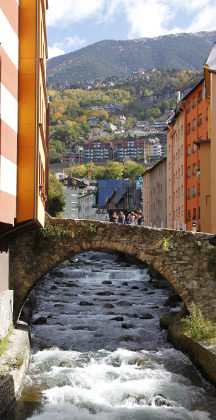 Andorra la Vella is the capital city of Andorra and has become wealthy as a tax haven for Spain and as a location for tax-free shopping. Most of the city is therefore modern and commercial with many private banks, jewelry and electronics stores, fashions and of course, tobacco and spirits outlets. The city sits in quite a vertical narrow valley with mountains all around and though there were some lovely autumnal colours on the mountain-sides, the setting is not particularly picturesque.
Andorra la Vella is the capital city of Andorra and has become wealthy as a tax haven for Spain and as a location for tax-free shopping. Most of the city is therefore modern and commercial with many private banks, jewelry and electronics stores, fashions and of course, tobacco and spirits outlets. The city sits in quite a vertical narrow valley with mountains all around and though there were some lovely autumnal colours on the mountain-sides, the setting is not particularly picturesque.
There is a river and older parts of the city that can seem a little lost among all the new buildings and villas clinging to the sides of the hills. The northern part of the city is Les Escaldes with an ancient bridge and a handful of older buildings by the river. Then following the river downstream you pass a large glass and steel centre before coming back into the main commercial axis.
The commercial areas of the city are mostly pedestrianised with a number of large malls and shopping centres. If you are shopping, it's important to realise that this is a genuine old-school duty-free area. That is there are restrictions on how much you can take back out into Spain (or France) and customs and police regularly do spot-checks as you cross the border.
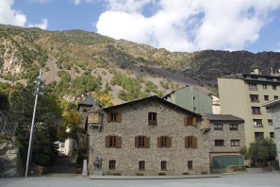 The heart of the old part of the city is further towards the frontier above the river area with a small church, a small castle and a handful of older buildings. Almost like a Catalan village surrounded by modern apartment blocks and buildings. This is also the only country (currently) where Catalan is the national language and you do see signs in Catalan around the town. There is also a strong French influence and because of the skiing, a number of English bars around town which gives Andorra more of an international feel.
The heart of the old part of the city is further towards the frontier above the river area with a small church, a small castle and a handful of older buildings. Almost like a Catalan village surrounded by modern apartment blocks and buildings. This is also the only country (currently) where Catalan is the national language and you do see signs in Catalan around the town. There is also a strong French influence and because of the skiing, a number of English bars around town which gives Andorra more of an international feel.
Our overall impression is that there's a novelty in visiting once but that, unless you're into skiing, with the long journey it's not a place we're drawn back to.
Also in France close to the Costa Brava
White water rafting in Quillan (France) - Collioure (France) - Villefranche-de-Conflent and Mont-Louis (France) - Perpignan - Elne (France) - Ceret (France)
For the mountains
Ribes de Freser and skiing at Vall de Nuria - Mollo (Camprodon) - Pyrenees to France - Visit to Setcases - Puigcerda and Bourg-Madame
See also: Figueres and Castell de Sant Ferran - Girona - Festa Major of Sant Narcis - Perpignan
Santa Coloma de Farners
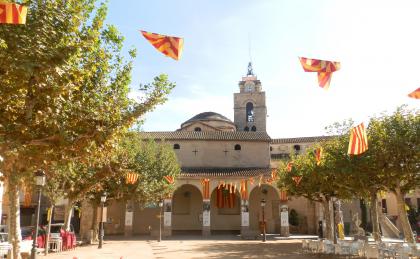
 Autumn's beckoning and as has become an annual habit we head to Montseny - this year to Santa Coloma de Farners just to the South West of Girona. It's a town we've visited several times mainly for the walk in the hills to the Ermitage that looks over the town and the wonderful autumnal park of Sant Salvador - a glorious crunchy leaves and dappled sunlight type of park that runs along the river.
Autumn's beckoning and as has become an annual habit we head to Montseny - this year to Santa Coloma de Farners just to the South West of Girona. It's a town we've visited several times mainly for the walk in the hills to the Ermitage that looks over the town and the wonderful autumnal park of Sant Salvador - a glorious crunchy leaves and dappled sunlight type of park that runs along the river.
This year October is proving to be surprisingly warm - 26C or 27C. At the coast people are still swimming, let alone sunbathing. Inland at Santa Coloma the temperatures are also warm so rather than walk to the Ermitage we take a shorter route around the unusual rock formations of Roques Alls.

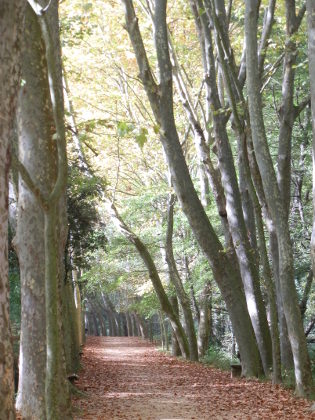 We park in the centre of the town and for the first twenty minutes or take a short walk through the town streets which, being Sunday, are pretty much empty of people. The main placa for Santa Coloma is just the other side of the church and has been decked out with Catalan flags. We're between the Diada (11th September) and its massive demonstration for Catalan independence and the impending date of the Vote for the Consulta which will ask Catalan people whether they want to be independent or to have more autonomy within Spain.
We park in the centre of the town and for the first twenty minutes or take a short walk through the town streets which, being Sunday, are pretty much empty of people. The main placa for Santa Coloma is just the other side of the church and has been decked out with Catalan flags. We're between the Diada (11th September) and its massive demonstration for Catalan independence and the impending date of the Vote for the Consulta which will ask Catalan people whether they want to be independent or to have more autonomy within Spain.
From the Placa we walk up to the Carrer Dalt (upper street) just above the town with views across to the hills and Montseny in the direction we'll be walking. The street isn't too long and we soon come back into town and then find a path past allotments to the main park of Sant Salvador, crossing the river by a small footbridge.
 The park is a highlight of Santa Coloma, tall trees planted in formation rise above a flat grass area next to a wide, but shallow river. The autumn light piercing the leaves leaving pools of illumination in among the shaded paths. The paths are patterned with leaves that crunch under foot, while it's still warm enough for children to be splashing in the river shallows.
The park is a highlight of Santa Coloma, tall trees planted in formation rise above a flat grass area next to a wide, but shallow river. The autumn light piercing the leaves leaving pools of illumination in among the shaded paths. The paths are patterned with leaves that crunch under foot, while it's still warm enough for children to be splashing in the river shallows.
The park is quite large, running along the river for about 1000m and includes a playground and a natural water spring that people visit to fill up water bottles making it a great place for a picnic or to bring younger children.
 We head up though, taking a path on the far side of the park from the weir/waterfall. There are a number of routes into the hills and our path quickly narrows, following what would be a torrent (a steep dry stream bed that channels water when it rains). It's not too far and we emerge at the base on large bare rocks and boulders. There are views from here across Santa Coloma and out towards the plain of Girona.
We head up though, taking a path on the far side of the park from the weir/waterfall. There are a number of routes into the hills and our path quickly narrows, following what would be a torrent (a steep dry stream bed that channels water when it rains). It's not too far and we emerge at the base on large bare rocks and boulders. There are views from here across Santa Coloma and out towards the plain of Girona.
We continue to head into the hills and then follow the signpost for Roques Alls - more rocks, some which look like they're balancing precariously above our heads. The path is a bit of a scramble between the boulders into a narrow gully, then up and out the other side emerging at another view point.
Our walking path then connects with a dusty gravel road track and we start to head down, but rather than keep to the road, we take a different path to the right and curl our way back down the hill to the park and back through the town to the car.
Nearby: Hostalric stroll - Lake at Sils - Castell de Montsoriu - Brunyola - Arbucies autumn walk - Visit to Roda de Ter and Espinelves - Caldes de Malavella - Volca de la Crosa - Sant Dalmai (Girona Airport)
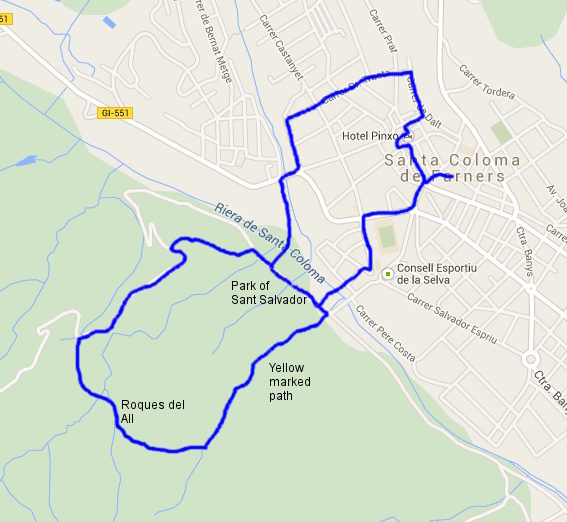
Banyoles lakeside walk
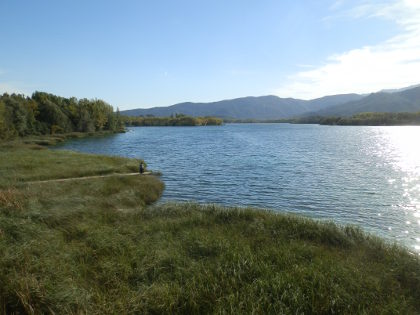 The Lake of Banyoles is the largest inland freshwater lake in Catalonia and is situated about a hour from the Costa Brava. The lake and town are surrounded by wooded hills and make for a perfect Autumn stroll in amongst the golden leaves as the trees turn colour.
The Lake of Banyoles is the largest inland freshwater lake in Catalonia and is situated about a hour from the Costa Brava. The lake and town are surrounded by wooded hills and make for a perfect Autumn stroll in amongst the golden leaves as the trees turn colour.
We park by the main sports centre where a festival or function is taking place, then walk across the paths through the sunken meadows to the side of the lake. The lake is about 5-6km around the outside so an easy flat stroll, but a large enough lake to really enjoy the water and views.
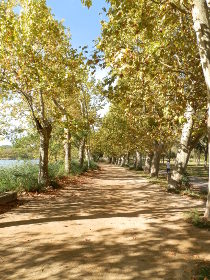 The lake itself has a number of boathouses that jut out into the water in fanciful shapes like castles above the water. We walk away from the town to start with towards the more natural end of the lake. This takes us past the reconstruction of a neolithic village that has been created to show how Banyoles' history goes back in time with exhibits of wattle and daub houses raised on stilts to protect them from flooding.
The lake itself has a number of boathouses that jut out into the water in fanciful shapes like castles above the water. We walk away from the town to start with towards the more natural end of the lake. This takes us past the reconstruction of a neolithic village that has been created to show how Banyoles' history goes back in time with exhibits of wattle and daub houses raised on stilts to protect them from flooding.
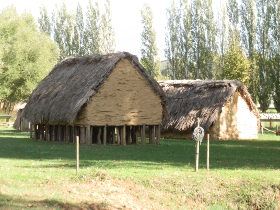 Our path continues around the lakeside into the woods which gleam in green with the light coming through the trees. We have our dog and given we're in natural woods its disappointing that she can't come off the lead, but that's also a challenge with a popular walk for families. The woods are full of ferns and water channels feeding into and out of the lake. And then we emerge at the other side by a sea of reeds and a modern wood design observation tower that's open for visitors. The extra height doesn't change the view too much but we can see the tourist boat on the lake taking tourists for short trips on the lake (€7 per person).
Our path continues around the lakeside into the woods which gleam in green with the light coming through the trees. We have our dog and given we're in natural woods its disappointing that she can't come off the lead, but that's also a challenge with a popular walk for families. The woods are full of ferns and water channels feeding into and out of the lake. And then we emerge at the other side by a sea of reeds and a modern wood design observation tower that's open for visitors. The extra height doesn't change the view too much but we can see the tourist boat on the lake taking tourists for short trips on the lake (€7 per person).
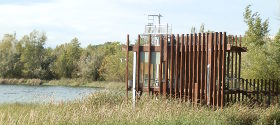
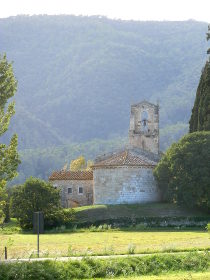 Our path continues past the top of the lake and past the first of two bathing areas we would pass. This one is natural and open, but swimming is only allowed on the lake in July, August and the first parts of Septmber. We cross over a number of small streams that either feed or take water from the lake. The meadows are full of a white daisy-like flower that grows almost on vines.
Our path continues past the top of the lake and past the first of two bathing areas we would pass. This one is natural and open, but swimming is only allowed on the lake in July, August and the first parts of Septmber. We cross over a number of small streams that either feed or take water from the lake. The meadows are full of a white daisy-like flower that grows almost on vines.
We turn down the other side walking back in woods but with the sun in front of us. The occasional side path runs to a jetty or the waters edge. After a brief while the path emerges by the side of a a road and continues along the roadside (separated and a proper path) until we pass the chapel at Porqueres. For this part of the walk we can see the water through the trees, while on the other side of the road are freshly ploughed fields with a rich deep brown soil that seems to extend up to the hills in the distance.
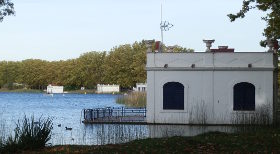 At Porqueres we get to the small church of Santa Maria and back into a more developed part of the lake with a campsite (still operating in October) and meadows that run to the side of the lake under a boulevard of plain trees. Along the edge of the lake we can see more of the boat houses and as we walk the area slowly becomes more commerical with sports stadium and bars and restaurants, and also more people walking and enjoying the sun. This is also where visitors can take a rowing boat or catch the boat trip on the lake.
At Porqueres we get to the small church of Santa Maria and back into a more developed part of the lake with a campsite (still operating in October) and meadows that run to the side of the lake under a boulevard of plain trees. Along the edge of the lake we can see more of the boat houses and as we walk the area slowly becomes more commerical with sports stadium and bars and restaurants, and also more people walking and enjoying the sun. This is also where visitors can take a rowing boat or catch the boat trip on the lake.
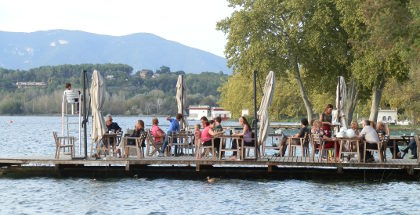 If you want to stop and take a drink or something to eat there is a small bar or restaurant built out over the water. The path continues along past the boat houses until we reach the large installations of the Club Natacion de Banyoles - a swimming and sports club and also the location of the second lido on the beach, but this time more private. The sports club is large with boats, an indoor pool and tennis courts and has to be negotiated around the back.
If you want to stop and take a drink or something to eat there is a small bar or restaurant built out over the water. The path continues along past the boat houses until we reach the large installations of the Club Natacion de Banyoles - a swimming and sports club and also the location of the second lido on the beach, but this time more private. The sports club is large with boats, an indoor pool and tennis courts and has to be negotiated around the back.
Then it's back along by the sunken meadows - presumably sunked to act as flood controls, and back to the main sports pavillion. We never did know what the event was.
Nearby: Sadernes and river pools of St Aniol d'Aguja - Sant Esteve d'En Bas (Olot) - Serinya and Illa del Fluvia - Olot - capital of Garrotxa - Palol de Revardit to La Mota - Bascara - horses, fords and lost - Esponella and River Fluvia - Bescano, River Ter and free-style kayaking - Visit to Besalu and Banyoles
Swimming at the lake: Swimming at Lake Banyoles
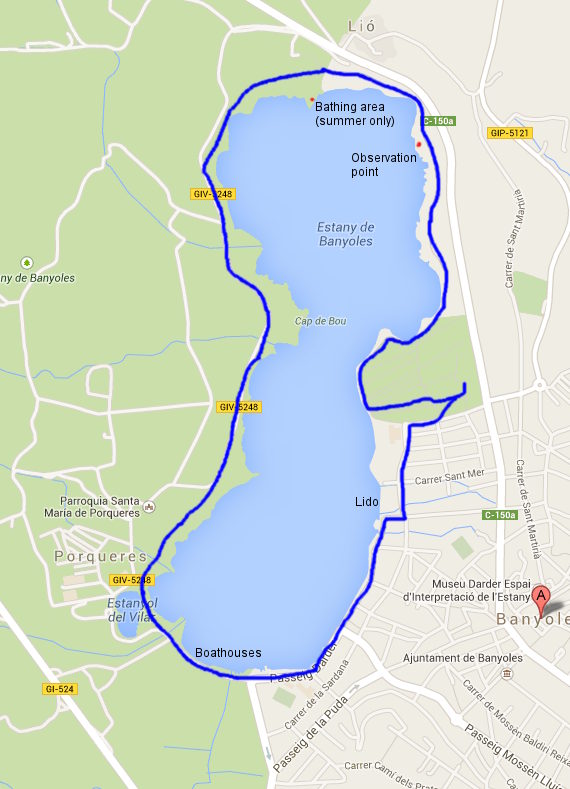
Cami de Ronda Calella de Palafrugell
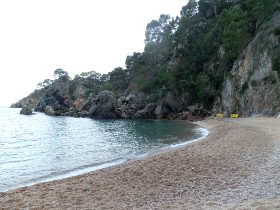 Calella de Palafrugell's Cami de Ronda on the Costa Brava is a short classic holidaymaker's walk with views over Mediterranean and hidden rocky coves, but enough interest to still be delightful as a regular walk for locals in and out of season.
Calella de Palafrugell's Cami de Ronda on the Costa Brava is a short classic holidaymaker's walk with views over Mediterranean and hidden rocky coves, but enough interest to still be delightful as a regular walk for locals in and out of season.
The walk is part of one of the earlier walks we did starting at Mont-ras, but this time we want to include just the Cami de Ronda part. Our starting point is at the beach of Golfet, the fourth (or so) of Calella de Palafrugell's beaches and the one most distant from the centre. Access to the beach and path is down steps from the upper road towards Cap Roig botanical gardens and is clearly sign-posted.
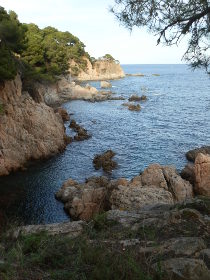 The steps down actually get to the path about 100m along from Golfet, so to make a full route we first go to the beach of Golfet itself, empty now in October. The beach is grittier and pebblier than the other village beaches, but sits in a natural cove with cliffs behind. In summer it's the quiet beach to get away from the crowds. In October there are signs of work to stablise the cliffside as it's situation also means erosiion and natural forces at work.
The steps down actually get to the path about 100m along from Golfet, so to make a full route we first go to the beach of Golfet itself, empty now in October. The beach is grittier and pebblier than the other village beaches, but sits in a natural cove with cliffs behind. In summer it's the quiet beach to get away from the crowds. In October there are signs of work to stablise the cliffside as it's situation also means erosiion and natural forces at work.
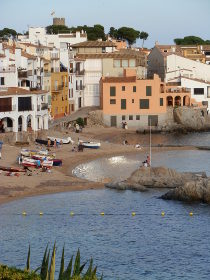 From Golfet the path passes past two large imposing isolated rocks before running into the first of a number of tunnels. The path is extremely well maintained and not a wild walk by any means, but as the path runs along the coast it still feels like an unspoilt walk.
From Golfet the path passes past two large imposing isolated rocks before running into the first of a number of tunnels. The path is extremely well maintained and not a wild walk by any means, but as the path runs along the coast it still feels like an unspoilt walk.
Each bend brings a new rocky bay, or you can take in the views of the red stone cliffs that give Cap Roig its name. The path is popular as a walk and even in October there are sunbathers and people who look as if they have just come out of the sea taking a stroll.
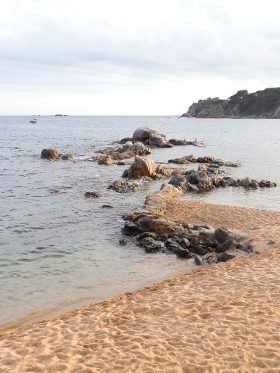 We pass a few more tunnels and out to see we get to see the small islands of Les Formigues (The Ants) marked by a low light house. The Formigues claim to fame was as the location of a naval battle between Catalans and the French in the 13th Century as part of the Aragonese Crusade when the King of Aragon was in dispute with the Pope. Now, in summer Calella de Palafrugell has a long distance swimming race to the Formigues and back - it's a long way 5-6km in total, so not to be tried without support and assistance.
We pass a few more tunnels and out to see we get to see the small islands of Les Formigues (The Ants) marked by a low light house. The Formigues claim to fame was as the location of a naval battle between Catalans and the French in the 13th Century as part of the Aragonese Crusade when the King of Aragon was in dispute with the Pope. Now, in summer Calella de Palafrugell has a long distance swimming race to the Formigues and back - it's a long way 5-6km in total, so not to be tried without support and assistance.
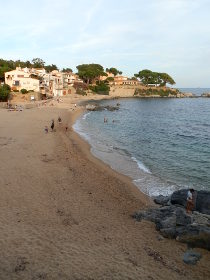 From the last long tunnel we get our first real view of Calella de Palafrugell in the autumn sunshine. The town is much much quieter than in summer and some places do close up, but the main restaurants by Port Bo tend to stay open year round. In October the bay is empty of the boats that normally moor here in the summer and the fine light makes it easy to take picture postcard type photographs.
From the last long tunnel we get our first real view of Calella de Palafrugell in the autumn sunshine. The town is much much quieter than in summer and some places do close up, but the main restaurants by Port Bo tend to stay open year round. In October the bay is empty of the boats that normally moor here in the summer and the fine light makes it easy to take picture postcard type photographs.
The path curves up briefly to the road at the top, before cutting down more stairs into and then up and out of a small bay. We've now reached Hotel Sant Roc and the terrace restaurant that looks over the town where dinners are just finishing lunch.
 The path now turns into a promenade along the tops of the main beaches of Port Pelegri by Hotel Mediterrani. The warm day, even for October means there are still people on the beach even in the afternoon, though no-one actually swimming.
The path now turns into a promenade along the tops of the main beaches of Port Pelegri by Hotel Mediterrani. The warm day, even for October means there are still people on the beach even in the afternoon, though no-one actually swimming.
The promenade walk runs down to sea-level at the heart of the village by Port Bo and its beach. People are sitting on the boardwalk by the restaurants and enjoying the views out to sea and out across to the path we've just walked. We follow the boardwalk past the old fishing boats on the beach and the old mini-harbour in the rocks. The path then cuts through the houses and we emerge with a view of the beach of Canadell. with the modernista buildings above the beach and the views to the headland that connects to Llafranc.
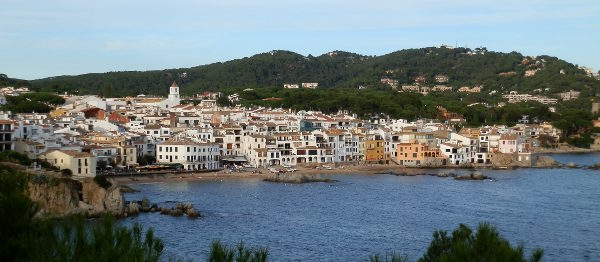
For longer walk that includes this path see: Mont-ras to Calella de Palafrugell and Llafranc
For neighbouring walks see: Calella de Palafrugell/Cap Roig to Castell - classic wild Costa Brava - Far de Sant Sebastia (Llafranc) to Tamariu - Eulogy to the Ruta del Tren Petit (Palafrugell, Palamos, Mont-ras and Vall-llobrega) - Gardens of Cap Roig - Palafrugell
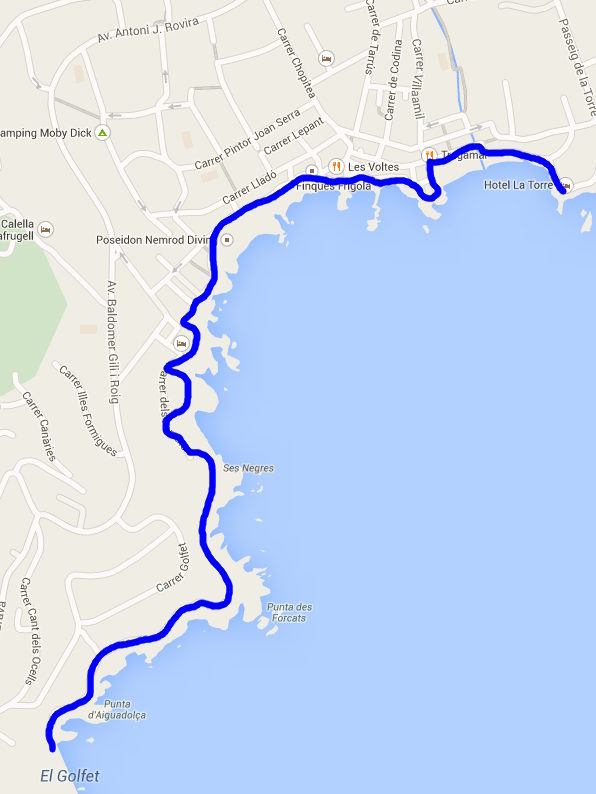
Comments | ||
adam@veggingoutwithadam.com |
17 Feb 2014 19:46 |
|
What a great blog. I am planning a walking holiday in the region and wonder if you can recommend the best walking maps, like UK ordnance survey ones. I shall be reading more of your walks over the coming days as we plan. Many thanks Adam | ||
Saul |
24 Feb 2014 17:25 |
|
Glad you're enjoying it. We have recommendations for maps in our 'Advice and FAQ' section | ||
Saul |
13 Jul 2017 12:46 |
|
Sorry I missed the comment, so I hope it's not too late - use the contact box if you'd like to send a message. For the coast, the GR92 is best and if you have driver you can just take it piece by piece. For hikers, around Cap de Creus is great, though it can be dry and hard walking in summer. For us, the stretch between Palamos and Palafrugell and on to Begur is the prettiest part of the whole Costa Brava and really good for walking. I'd probably also take the walk up and over Montgri, possibly starting at Pals, or L'Estartit to L'Escala. And though you said you prefer the coast, don't overlook inland routes as there are some wonderful villages and countryside out towards Girona, La Bisbal, or Olot. | ||
Sven-Gunnar Furmark |
24 May 2017 11:43 |
|
Hi, My name is Sven Furmark. I am from Sweden. I plan to go to Costa Brava with some friends (totally about 10 people) for hiking for one week (5 walking days). We are experienced hikers and we usually walk 4-6 hours per day. We prefer to walk along the coast as much as possible. We plan to rent a house and travel to each days hiking with a bus & driver which we plan to book for the whole week. Which five hikes would you recommend for us. Warm Regards Sven | ||

